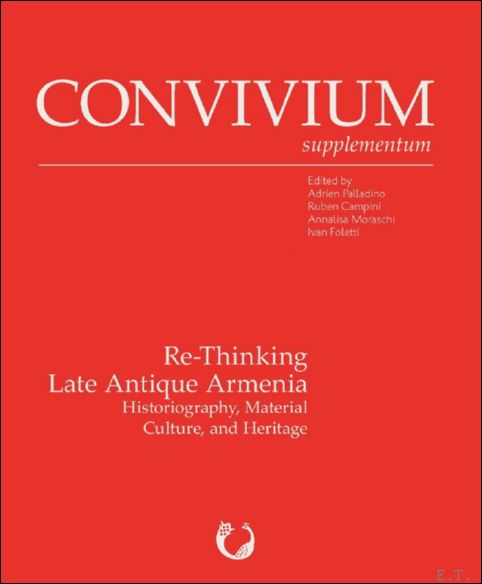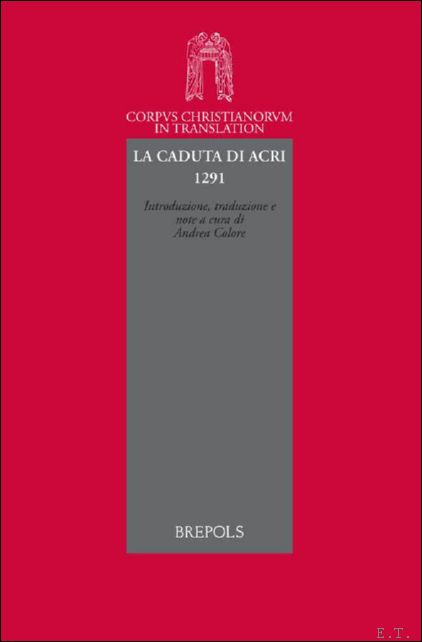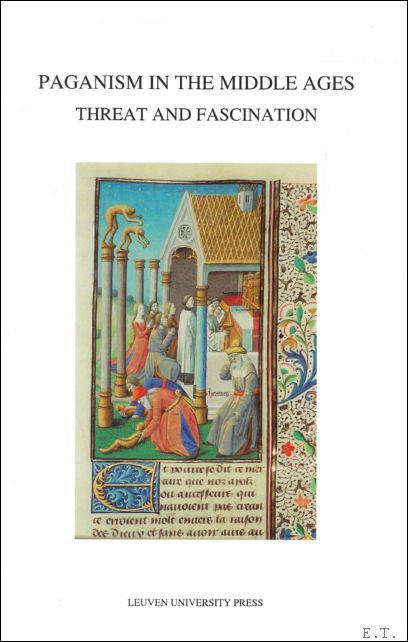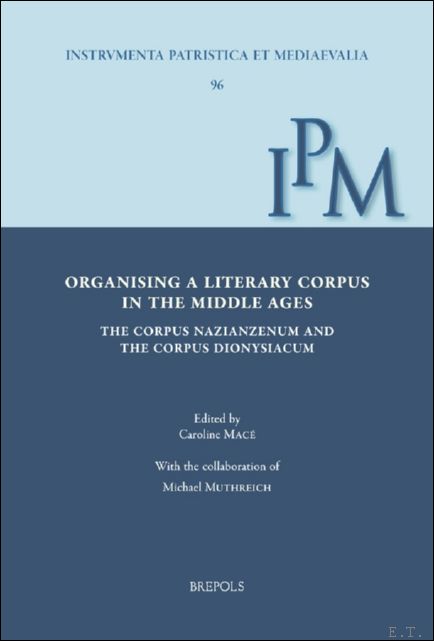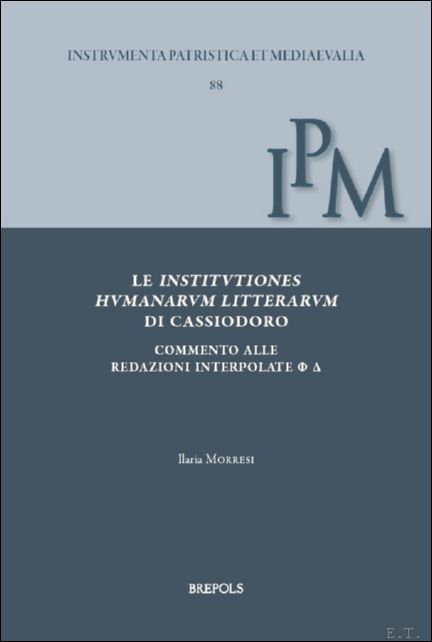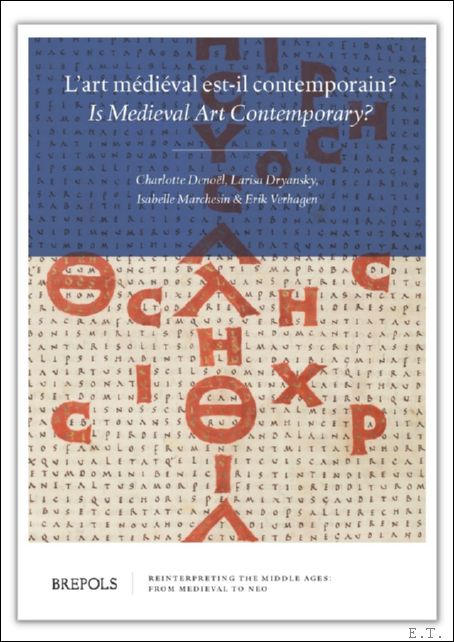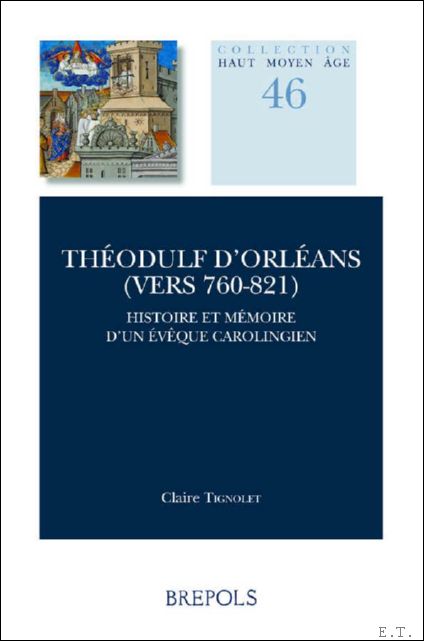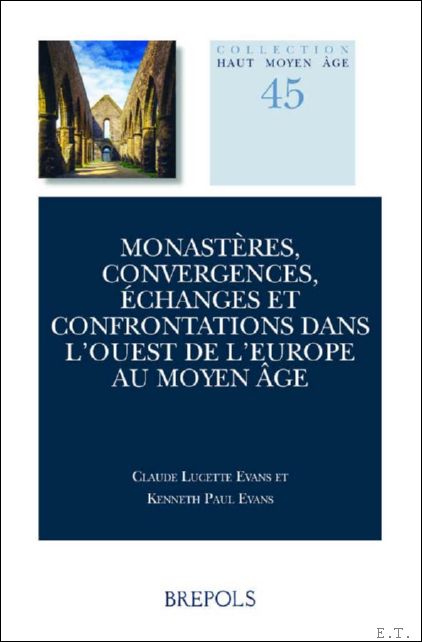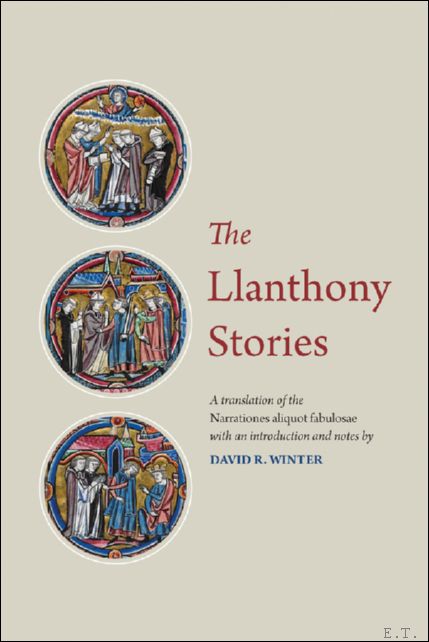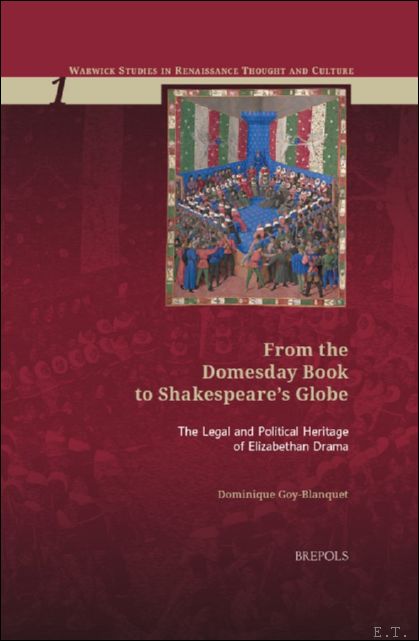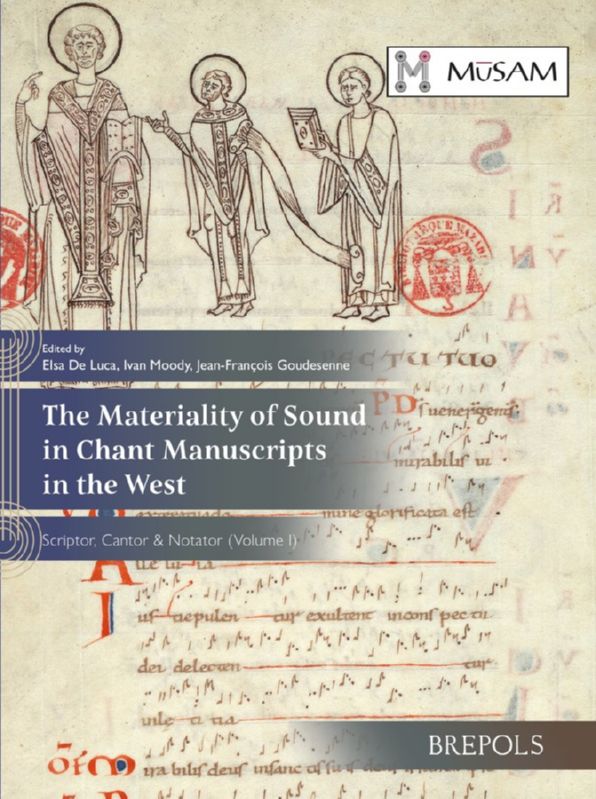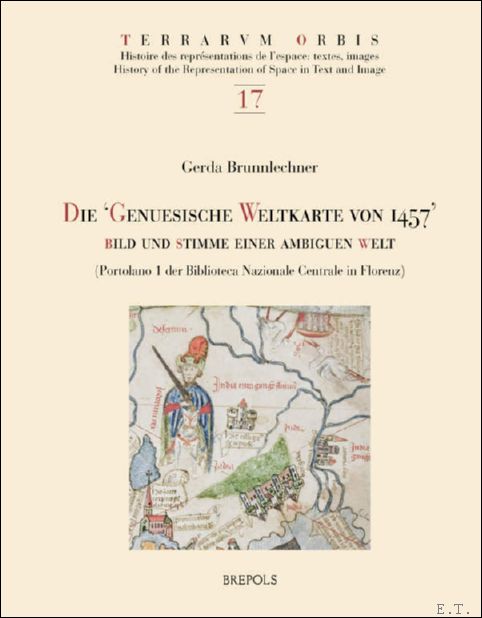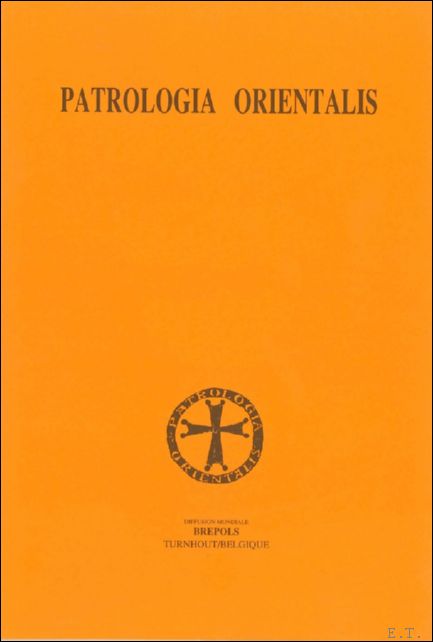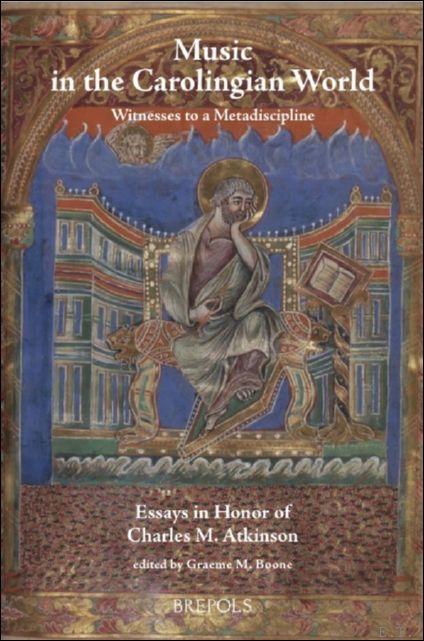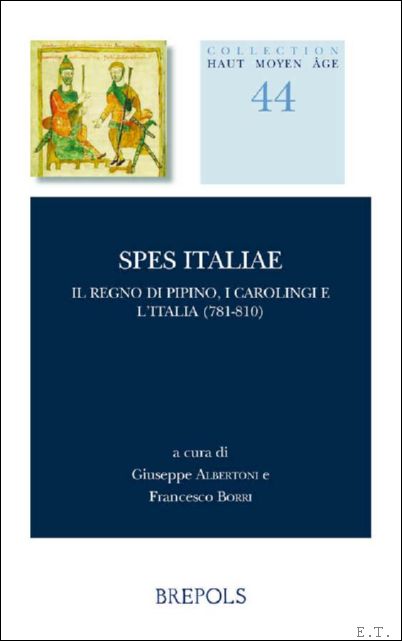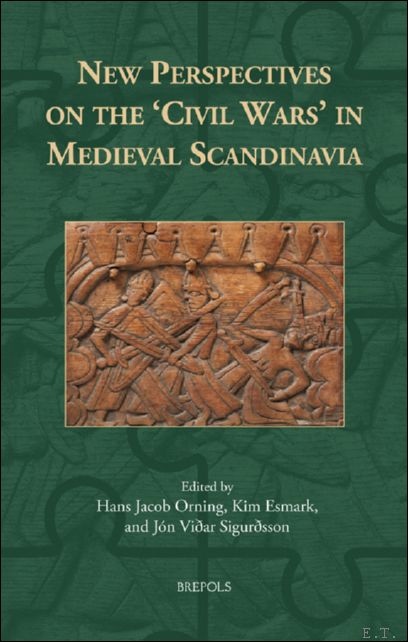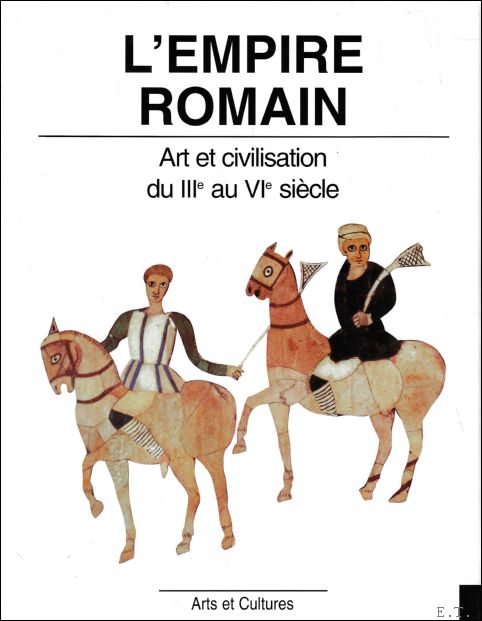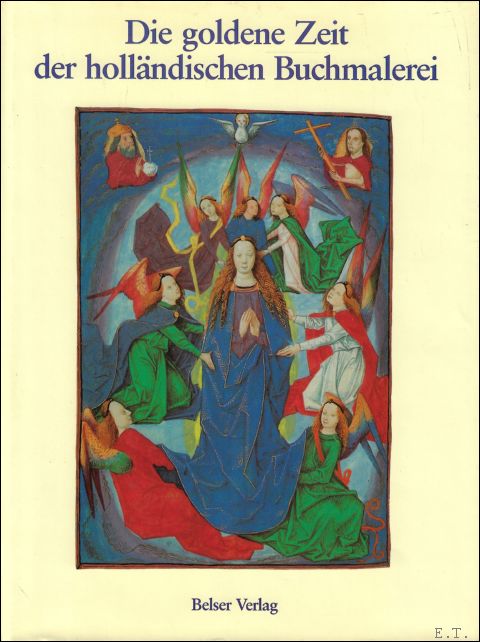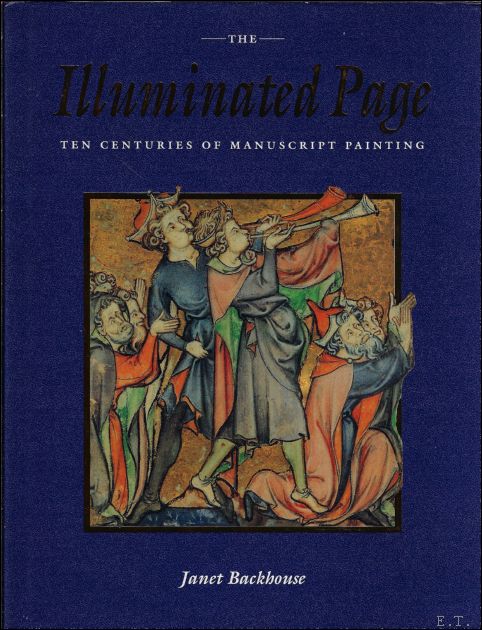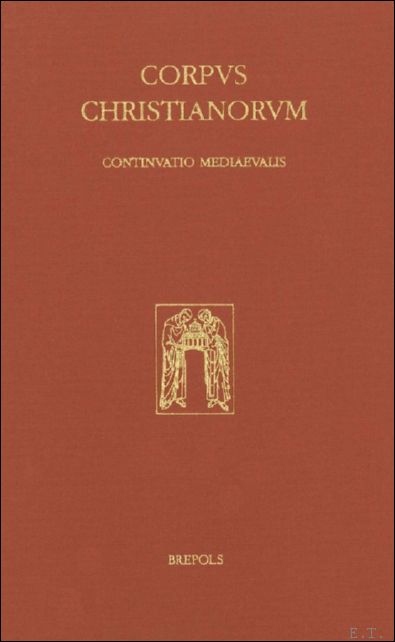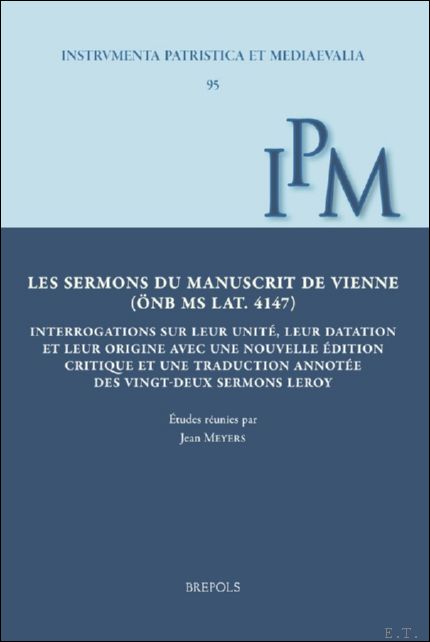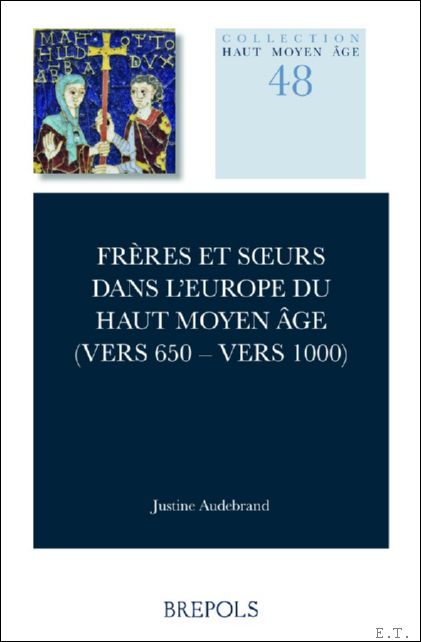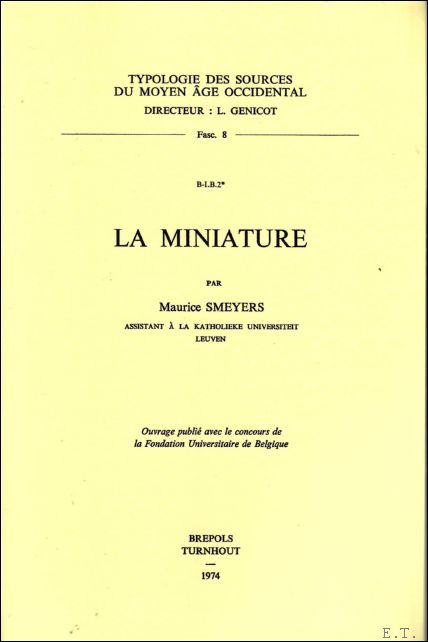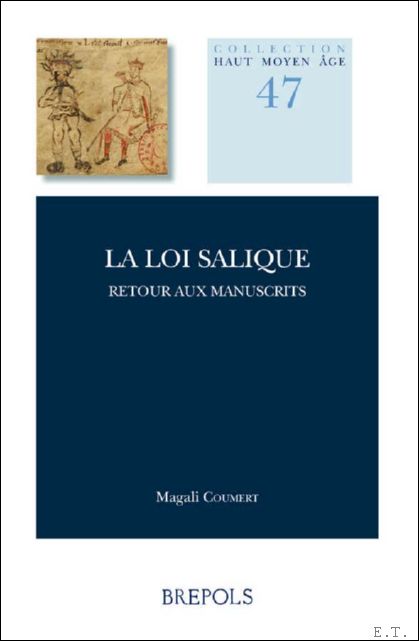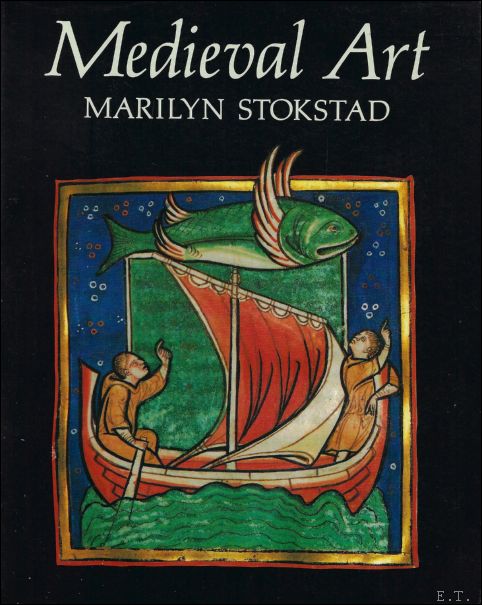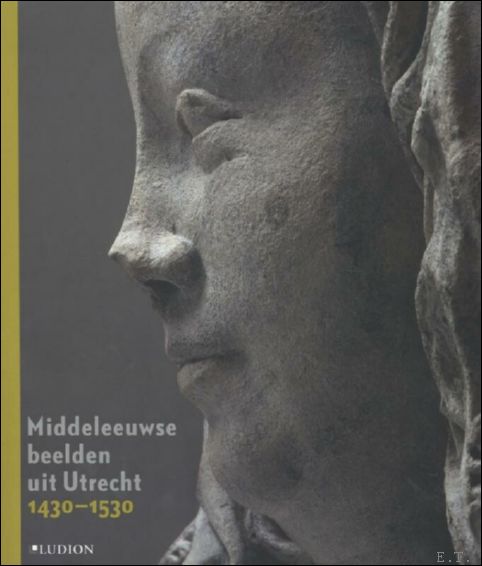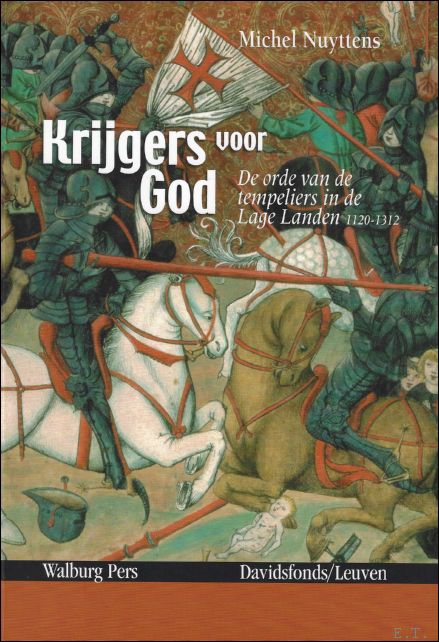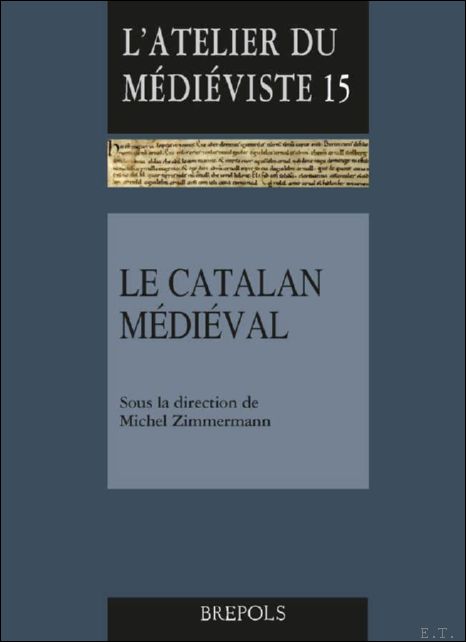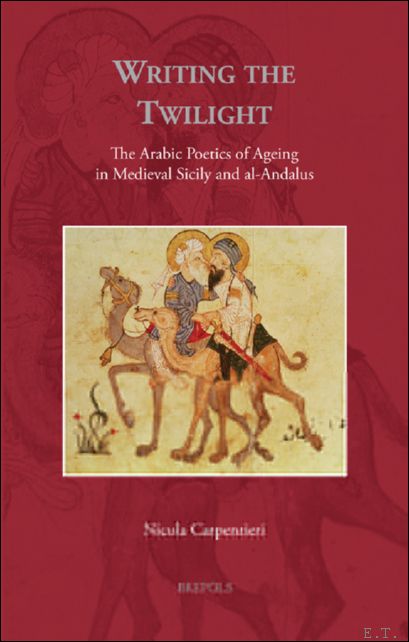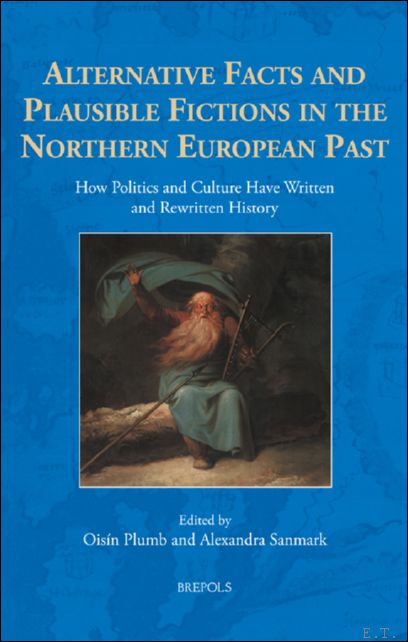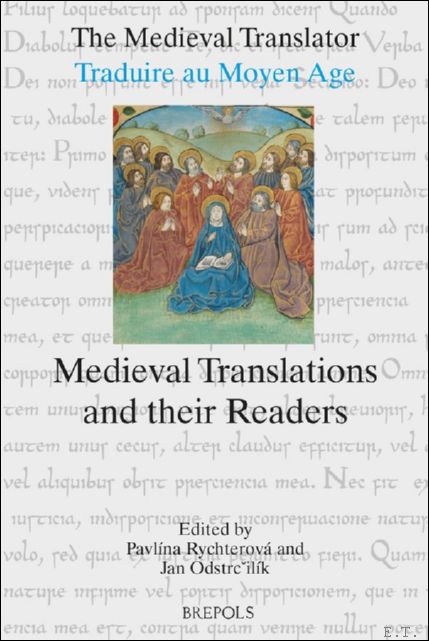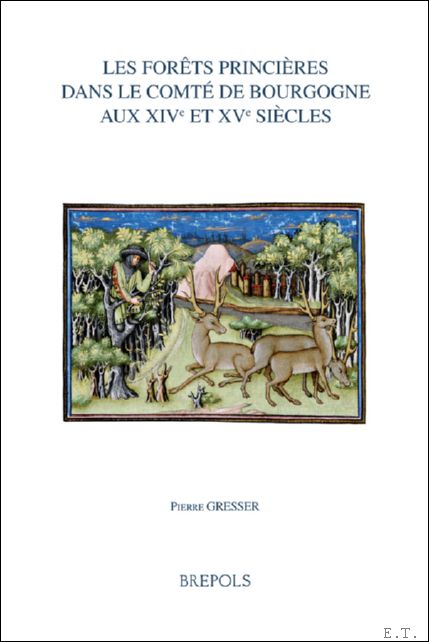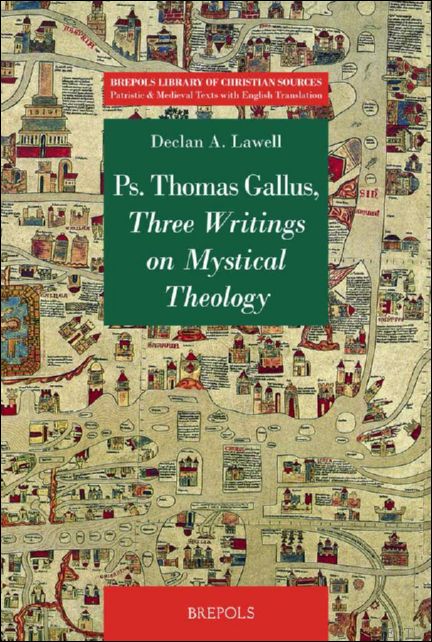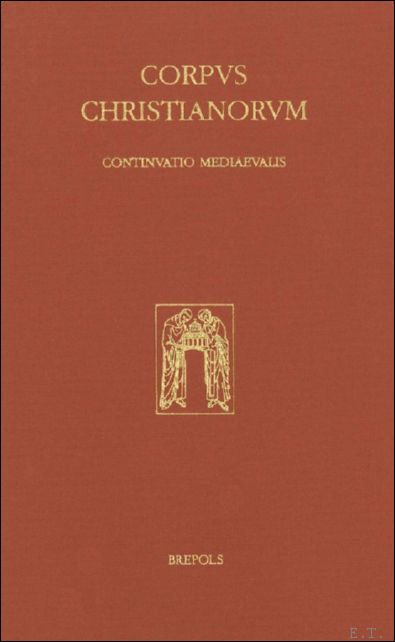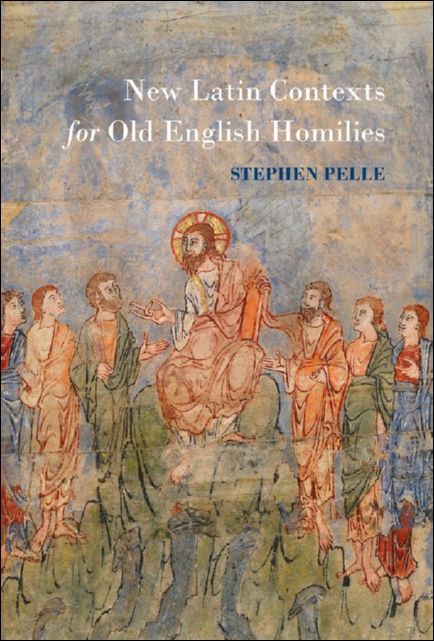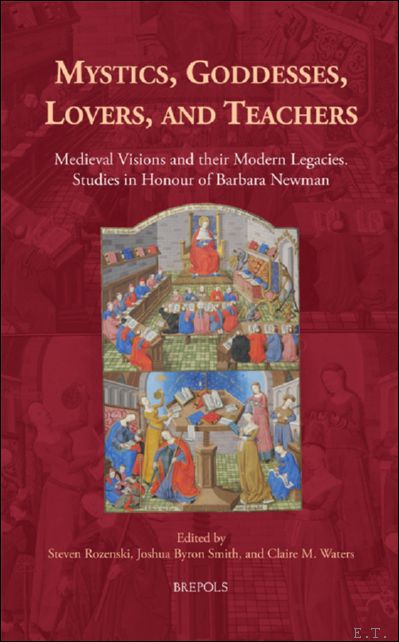Middeleeuwen
37 boeken gevonden
Pagina 1
Adrien Palladino, Ruben Campini, Annalisa Moraschi, Ivan Foletti (eds)
Re-Thinking Late Antique Armenia: Historiography, Material Culture, and Heritage
Brepols, 2023. Paperback, 191 pages, Size:210 x 270 mm, Illustrations:30 b/w, 125 col., 2 maps color, Language: English. ISBN: 9788028003067
Summary This book questions the place of Armenian visual and material culture in the period known as Late Antiquity, at a time when Armenia is usually presented as an in-between space defined by surrounding external entities: the Roman and the Persian, and later Arab world. The volume includes articles that confront this notion both from the perspective of art history, architecture, and archaeology, and from a historiographical point of view, which examines the reception of Armenian arts by scholars from Italy, Russia, and France. The articles in this richly illustrated volume aim to reposition Armenia as one of the forces of artistic creation and mediation to be reckoned with within the Mediterranean and Eurasian space of Late Antiquity. This project draws on the papers presented at the conference ?Re-Constructing Late Antique Armenia (2nd-8th Centuries CE). Historiography, Material Culture, Immaterial Heritage? that took place in February 2022 at the Center for Early Medieval Studies in Brno, Czech Republic. TABLE OF CONTENTS Introduction Ivan Foletti & Adrien Palladino Late Antiquity and Armenia. From Marginalized Region to Creative Force Articles Patrtick Donabédian Culmination of a Late Antique Legacy? The Golden Age of Armenian Architecture in the Seventh Century Nazénie Garibian The First Armenian Christian Sanctuaries and Shrines. Reconsidering the Received Tradition Lilit Mikayelyan Greco-Roman Ornamental Motifs in Armenia and Iran. Commonality and Sustainability of Tradition (5th-11th Centuries) Zaruhi Hakobyan The Image of St Christopher Cynocephalus in Early Medieval Sculpture of Armenia Adrien Palladino From Desperate Solidarity to Dispassionate Eye. Shifting French Perspectives on Early Medieval Armenian Art (ca 1894-1929) Annalisa Moraschi A Mutual Presentation. Precocious Interests for Medieval Armenia in Nineteenth-Century Italy Beatrice Spampinato A Theoretical Topography of Architecture. On the Problematic Connections between Rome, Byzantium, and Armenia in Italian Historiography (1914-1945) Ruben Campini Art from the Borders? Wolfgang Fritz Volbach and the Localization of a Group of Early Christian Ivory Pyxides in the Caucasus Ivan Foletti & Pavel Rakitin Re-Inventing Late Antique and Early Medieval Armenia in World War II Soviet Union Afterword Christina Maranci Late Antique Armenia. Past, Present, and Future
Boeknummer: 64336 | Prijs: EUR 75.00
Andrea Colore
La caduta di Acri 1291. Raccolta delle imprese legate allo sterminio di Acri - Taddeo di Napoli, Storia della desolazione e della distruzione della città di Acri e di tutta la Terra Santa
Brepols, 2023. Paperback, 168 pages, Size:156 x 234 mm, Illustrations:2 tables b/w., Language: Italian. ISBN: 9782503602646
Summary La caduta di San Giovanni d'Acri nel 1291, che segna la fine degli stati crociati d'Oltremare, rappresenta un punto di svolta nella storia medievale, già percepito come tale dai contemporanei. Sulla scia immediata dell'evento, due scritti narrano e commentano la battaglia: l'anonima Excidii Aconis gestorum collectio (composta probabilmente nel Nord della Francia) e l'Ystoria de desolatione et conculcatione ciuitatis Acconensis et tocius Terre Sancte di Taddeo di Napoli, venata di influssi gioachimiti. Entrambi ripercorrono con impressionante vividità le vicende che hanno portato allo scontro e soprattutto la disperata resistenza della città, mettendo in scena una molteplicità di personaggi nelle loro dinamiche di collaborazione e dissenso: i maestri degli Ordini Militari, i governanti e il patriarca, la folla dei combattenti e delle vittime inermi; dall'altra parte, i due sultani che si succedono nel corso degli eventi con il loro popolo di ?infedeli?, sinistri eppure valorosi. Lo stile adottato dall'Anonimo e da Taddeo è improntato a un preziosismo al limite talvolta della comprensibilità, che rende ardua la lettura nell'originale latino. La traduzione italiana mette a disposizione in modo più facilmente accessibile due fonti fondamentali per la storia delle crociate e della percezione di esse nella cultura del tempo. La versione latina originale dei testi qui tradotti è pubblicata nella collana Corpus Christianorum, Continuatio Mediaeualis con il titolo Excidii Aconis gestorum collectio; Ystoria de desolatione et conculcatione ciuitatis Acconensis et tocius Terre Sancte (CC CM, 202), a cura di R.B.C. Huygens (2004). I rimandi alle pagine corrispondenti dell'edizione sono forniti a margine di questa traduzione. TABLE OF CONTENTS Introduzione Bibliografia Raccolta delle imprese legate allo sterminio di Acri Taddeo di Napoli, Storia della desolazione e della distruzione della città di Acri e di tutta la Terra Santa Appendice 1: Gli ordini militari Appendice 2: Armi e macchine d'Assedio notevoli. Il lessico della guerra medievale Indici
Boeknummer: 64496 | Prijs: EUR 45.00
Carlos Steel, John Marenbon, and Werner Verbeke
Paganism in the Middle Ages : Threat and Fascination
UPL, 2013. 1. Softcover with flaps, 250 pages, ENG edition, 240 x 160 x 20 mm, New condition, a few b/w illustrations. ISBN: 9789058679338
Interdisciplinary study of pagan culture from late antiquity to the emergent Renaissance In this volume the persistence, resurgence, threat, fascination, and repression of various forms of pagan culture are studied in an interdisciplinary perspective from late antiquity to the emergent Renaissance. Contributions deal with the survival of pagan beliefs and practices, as well as with the Christianization of pagan rural populations or with the different strategies of oppression of pagan beliefs. The authors examine problems raised by the encounter with pagan cultures outside the Muslim world and show how philosophers contrived to ?save' the great philosophers and poets from ancient culture notwithstanding their paganism. The contributors also study the fascination of classic ?pagan' culture among friars during the fourteenth and fifteenth centuries and the imitation of pagan models of virtue and mythology in Renaissance poetry. Contributors Carlos Steel (University of Leuven), John Marenbon (Trinity College, Cambridge), Ludo Milis (University of Ghent), Marc-André Wagner ? (Paris, Ministère de la Culture), Brigitte Meijns (University of Leuven), Rob Meens (University of Utrecht), Edina Bozoky (Université de Poitiers), Henryk Anzulewicz (Albertus-Magnus Institut, Bonn), Robrecht Lievens (University of Leuven), Stefano Pittaluga (Università di Genova), Anna Akasoy (Ruhr-Universität Bochum)
Boeknummer: 62800 | Prijs: EUR 59.50
Caroline Macé (ed)
Organising a Literary Corpus in the Middle Ages. The Corpus Nazianzenum and the Corpus Dionysiacum
Brepols, 2024. Hardback, 700 pages, Size:156 x 234 mm, Illustrations:6 b/w, 15 col., 12 tables b/w., Language(s):English, French, German. ISBN: 9782503610962
Summary Through the word corpus, the metaphor of the body is applied to a collection of works by the same author that are transmitted together. These works not only share the same skin, the manuscript, but also function organically thanks to a complex system of paracontents. It is possible to see this system at work in the case of only a very few medieval authors throughout history, cultures and languages; the Corpus Nazianzenum and the Corpus Dionysiacum are such instances. Both Gregory of Nazianzus and Dionysius the Areopagite are super-authors, who forged their own literary identity as much as they shaped the body of their writings. This sets both corpora apart from other collections of patristic works. They are also exceptional because of the large scale and enduring character of their cultural impact in the different cultures in which the corpora were translated, commented and annotated. By confronting these two exceptional cases, it is possible to gain some new light on the intellectual and book-historical aspects of literary creation and reception in Late Antiquity and the Middle Ages. TABLE OF CONTENTS Introduction 1. Caroline Macé: Living Bodies of Texts 2. Ekkehard Mühlenberg: Das Akademievorhaben ?Dionysius Areopagita? in Göttingen 3. Bernard Coulie: Le Centre d'études sur Grégoire de Nazianze à Louvain-la-Neuve I. Origins and Evolutions of the Corpora 1. Margherita Matera: Le palimpseste Parisinus graecus 1330, le plus ancien témoin manuscrit du Corpus Dionysiacum 2. Caroline Macé: Éléments d'une histoire ancienne de la tradition des discours de Grégoire de Nazianze: les variantes arméno-latines du discours 38 3. Alessandro Capone: Alle origini delle antiche versioni latine delle Orazioni di Gregorio di Nazianzo 4. Véronique Somers: Sur les traces d'une édition byzantine des Discours de Grégoire de Nazianze ? 5. Pierre-Marie Picard: Les divisions mauristes des ?uvres poétiques de Grégoire de Nazianze, des sous-corpus évolutifs à interroger 6. Jost Gippert: Ephrem the Minor's Preface Revisited 7. Maia Matchavariani: Books for Bibliophiles: Two Ancient Collections of the Georgian Translations of Gregory of Nazianzus' Works - NCM S-1696 and NCM A-87 II. Scholia and Commentaries 1. Chiara Faraggiana: Gehören ???????????, ?????????????, ??????????? zum literarischen oder zum kodikologischen Vokabular? Überlegungen über die spätantike Exegese als Paratext 2. Joseph Church: The Ancient Lexica to the Corpus Dionysiacum 3. Thomas Schmidt: Les Commentaires de Basile le Minime aux Discours de Grégoire de Nazianze: le cas particulier du Discours 38 4. Gaëlle Rioual: Basile le Minime, commentateur de quel texte de Grégoire de Nazianze? 5. Jonathan Loopstra: Reading the Corpus Nazianzenum in Syriac by Way of the Margins 6. Emiliano Fiori: School and Scholia in the Syriac Miaphysite Tradition: The Syriacisation of Dionysius the Areopagite as a Collective Exegetical Effort 7. Sergio La Porta: Reading the Areopagite: The Armenian Scholia on the Corpus Dionysiacum and Their Use in the Medieval School Curriculum 8. Thamar Otkhmezuri: The Corpus Nazianzenum and the Corpus Dionysiacum in the Georgian Literary Tradition
Boeknummer: 64174 | Prijs: EUR 115.00
Cassiodorus Senator, Ilaria Morresi(ed)
Le Institutiones humanarum litterarum di Cassiodoro. Commento alle redazioni interpolate ? ?
Brepols, 2023. Hardback, 554 pages, Size:156 x 234 mm, Illustrations:72 b/w, 15 tables b/w., Language(s):Italian, Latin. ISBN: 9782503595900
Summary The Institutiones humanarum litterarum - that is, the second book of Cassiodorus' masterpiece, devoted to secular learning - have come down to us in three different textual forms: the 'authentic' recension ?, corresponding to Cassiodorus' final wishes, and two subsequent recensions, designated as ? and ?. In these two recensions, later interpolations were added on the basis of an earlier authorial draft, providing modern readers with valuable information both about Cassiodorus' progressive revisions and about the early fortune of his work. This volume provides a full commentary to the first critical edition of the interpolated recensions ? and ? (CC SL 99A). In doing so, it conveys a full picture of the complex history of the Institutiones saeculares, from their first appearance in the monastery of Vivarium to the Carolingian Renaissance, at which time they knew their greatest success and circulation. TABLE OF CONTENTS Parte I: Le redazioni d'autore delle Institutiones humanarum litterarum I. Introduzione e stato dell'arte 1. Caratteristiche e contenuto delle tre redazioni 2. Rimaneggiamenti delle Institutiones 3. Redazioni intermedie delle Institutiones humanae 4. Alcune obiezioni all'ipotesi tradizionale di Courcelle 5. Piano del presente lavoro II. Il testo-base di ? ?: varianti d'autore alle Institutiones 1. Un ulteriore rimaneggiamento d'autore ? alla base di II? 2. Analisi testuale di ?: errori d'archetipo nel brouillon 3. Il brouillon di Cassiodoro è stato scritto a Vivarium? Parte II: La redazione II I. Interpolazioni interne alle Institutiones 1. Gli estratti da Marziano Capella 2. Gli estratti dal De topicis differentiis di Boezio II. L'appendice II 1. Il trattato De topicis 2. De syllogismis, De paralogismis e De propositionum modis 3. Il Computus Paschalis 4. I Praecepta artis rhetoricae di Severiano 5. Il trattato De dialecticis locis 6. Conclusioni sull'Appendice II Parte III: La redazione III I. Institutiones humanarum litterarum 1. Il capitolo De grammatica 2. Il capitolo De rethorica 3. Il capitolo De dialectica 4. I capitoli del Quadriuium 5. Conclusioni sulle Institutiones ? II. Interpolazioni lunghe all'interno delle Institutiones 1. Gli estratti da Quintiliano 2. Estratti dal De institutione arithmetica di Boezio 3. I Principia geometricae disciplinae III. L'appendice ? 1. L'interpolazione sugli elementi 2. Gli estratti da Agostino 3. Schema In exponendis considerare conuenit haec 4. Schema Aut cantantium 5. Il Carmen de uentis e la Rota uentorum 6. La dedica Dominus qui iussit 7. Estratti dal De institutione musica di Boezio 8. L'Anecdoton Holderi 9. Conclusioni sull'Appendice ? Parte IV: Conclusioni 1. La redazione ? delle Institutiones humanarum litterarum 2. La redazione II 3. La redazione III Appendice di immagini Bibliografia Indici
Boeknummer: 64374 | Prijs: EUR 125.00
Charlotte Denoël, Larisa Dryansky, Erik Verhagen, Isabelle Marchesin (eds)
L'art médiéval est-il contemporain ? Is Medieval Art Contemporary?
Brepols, 2023. Hardback, 247 pages, Size:178 x 254 mm, Illustrations:5 b/w, 66 col., Language(s):English, French. ISBN: 9782503599731
Summary This publication brings together essays by scholars of both medieval and contemporary art, offering a cross-disciplinary approach of both periods. It investigates how contemporary artists and contemporary art historians perceive medieval art, and, reciprocally, how medieval art historians envisage the echoes of medieval artforms and esthetics in contemporary art. The volume follows on from the symposium organized in conjunction with the exhibition "Make it New: Carte Blanche à Jan Dibbets" that was held at the Bibliothèque Nationale de France (Paris) in 2019, and which presented side by side Hrabanus Maurus's De Laudibus Sanctae Crucis (In Praise of the Holy Cross), a masterpiece of Carolingian art, with works by artists associated with conceptual art, mininimal art, and land art. How and why has medieval art, and particularly early medieval art, inspired contemporary artists since the 1950s? What has medieval art contributed to contemporary art? How has medieval art's treatment of figures, color, space, geometry, and rhythm provided inspiration for contemporary artists' experiments with form? In what way does contemporary artists' engagement with the topics of formatting, writing, semiosis, mimesis, and ornamentation draw inspiration from medieval models? To what extent and in what sense are the notions of authorship and performativity relevant for understanding conceptions of artmaking in both periods? Rather than focusing on medievalism and citational practices, or on the theory of images?both approaches having already produced an important body of comparative readings of medieval and contemporary art?the essays in this volume address the question of medieval art's contemporaneity thematically, through three trans-chronological topics: authorship, semiosis and mathematics, and performance. Engaging the artists' works as well as their writings, these studies conflate conceptual and esthetic perspectives. TABLE OF CONTENTS Préface Charlotte Denoël, Larisa Dryansky, Isabelle Marchesin et Erik Verhagen Partie 1. Introduction Au-delà des périodisations : Parcours passés et futurs potentiels Nancy Thebaut Partie 2. Auctoritas/authorship Qui était Jean Fouquet pour François Robertet ? Une question d'auctorialité dans l'art de la fin du Moyen Âge Elliot Adam L'artiste conceptuel à son pupitre Valérie Mavridorakis Art conceptuel et scolastique : le Chêne de Michael Craig-Martin est-il thomiste ? Benjamin Riado Partie 3. Signe et mathématiques ?All form is a process of notation?: Hrabanus Maurus's ?exemplativist? art Aden Kumler' Les nombres de la forme et les formes du nombre. Essai sur les carolingiens et l'abstraction. Isabelle Marchesin Abstraction in Medieval Art: The Chiasm in Hagia Sophia Bissera Pentcheva Hollis Frampton, médiéval Larisa Dryansky Partie 4. Performance La conversion du précieux sang : Gina Pane et la mystique médiévale Janig Bégoc Automata, Kineticism, and Automation: An Oblique History of Animacy in the Art of the Long 1960s Roland Betancourt Coda Zoe Leonard's Suitcases Amy Knight Powell Liste des contributeurs
Boeknummer: 64422 | Prijs: EUR 85.00
Claire Tignolet
Théodulf d?Orléans (vers 760-821). Histoire et mémoire d?un évêque carolingien
Brepols, 2023. Paperback, 291 pages, Size:156 x 234 mm, Illustrations:3 col., 4 tables b/w., Language: French. ISBN: 9782503601588
Summary Parmi les lettrés entrés au service de Charlemagne à la fin du VIIIe siècle, Théodulf est une figure à la fois représentative et singulière. Par ses productions et ses fonctions de missus, d'évêque, d'abbé, il contribue à l'élaboration et à la mise en ?uvre des réformes et fait partie des proches du souverain. Sa déposition en 818 jette cependant une ombre sur sa carrière et sur ce qu'il est possible d'en reconstituer. À partir de l'étude de son ?uvre et des variations de son image dans les sources du premier Moyen Âge, y compris manuscrites, cet ouvrage examine les différentes facettes de son action et de son parcours, comme lettré et comme prélat, et met en lumière le jeu d'échelles qui caractérise les réformes carolingiennes. Grâce à l'analyse de son environnement relationnel, la participation de Théodulf à la révolte de Bernard d'Italie et sa disgrâce font l'objet de nouvelles hypothèses. TABLE OF CONTENTS Liste des illustrations Remerciements Avertissement Introduction Théodulf : un bilan historiographique Pour une approche biographique Prologue. La déposition de Théodulf La courte épitaphe d'un prélat mort en exil Un fait marquant pour les contemporains Théodulf et la révolte de Bernard d'Italie dans l'historiographie Un corpus affecté par sa déposition ? Chapitre 1. Le souvenir et la mémoire du prélat Théodulf dans l'historiographie carolingienne Théodulf dans la mémoire locale Des strates mémprielles entremêlées Conclusion Chapitre 2. Mobilité et déplacements au service du souverain De l'Espagne à la cour L'installation de Théodulf à Orléans Les déplacements d'un agent du roi Sous Louis le Pieux, la mise à l'écart de Théodulf Conclusion Chapitre 3. Un évêque réformateur entre la cour et Orléans Un Savant engagé dans les travaux intellectuels de la cour Un agent de la mise en ordre carolingienne Un bâtisseur dans l'Orléanais Un artisan de la Renaissance carolingienne Conclusion Chapitre 4. Théodulf, un homme de réseaux Un proche de Charlemagne Rivalités et amitiés autour de Théodulf Des liens en recomposition sous Louis le Pieux Conclusion Épilogue. Le retour en grâce Le poème Hesperia genitus Un contexte favorable La diffusion du corpus d'exil Jeux d'échelles Bibliographie Index des noms de personnes Index des noms de lieux
Boeknummer: 64456 | Prijs: EUR 80.00
Claude Lucette Evans, Kenneth Paul Evans (eds)
Monastères, convergences, échanges et confrontations dans l?Ouest de l?Europe au Moyen Âge. Actes du Colloque Anciennes Abbayes de Bretagne, Université de Toronto 5-6 mai, 2016
Brepols, 2023. Paperback, 390 pages, Size:156 x 234 mm, Illustrations:5 b/w, 2 col., 14 tables b/w., 8 maps b/w, 12 maps color, Language: French. ISBN: 9782503599854
Summary L'orientation vers les convergences, échanges et confrontations dans l'histoire monastique du grand Ouest européen au Moyen Âge permet de porter un regard nouveau sur la dynamique de divers établissements en observant les relations qui s'y sont développées tant au sein des communautés, qu'avec la société environnante. Les influences externes subies par les monastères et les conflits internes qui s'y jouent, les échanges dus aux pèlerinages, aux rouleaux des morts et aux confraternités sont au nombre des thèmes explorés. TABLE OF CONTENTS Liste des cartes et des illustrations Abréviations Remerciements Introduction, Catherine Vincent, MéMo, Université Paris Nanterre I. Monastères bretons Caroline Brett, Université de Cambridge, 'Monastères, migration et modèles. L'église bretonne du haut Moyen Âge' Joseph-Claude Poulin, Université de Montréal, 'Alet, Landévennec, Redon. Trois ateliers d'écriture hagiographique vers 870' Yves Gallet, AUSONIUS, Université de Bordeaux, 'Landévennec, Redon, le Mont Saint-Michel. Topographie et architecture des abbayes de Bretagne dans le monde carolingien' Joëlle Quaghebeur, Université de Bretagne-Sud (E. R.), 'Les abbayes Sainte-Croix de Quimperlé et Saint-Sauveur de Redon aux XIe et XIIe siècles. Fraternitas, amicitia et calumpnia Julien Bachelier, Université de Bretagne occidentale, 'Les abbayes en Haute-Bretagne aux XIe-XIIe siècles. Convergences et confrontations' II. Tensions internes dans le monde monastique de l'Ouest Bernard Ardura, Commission historique, Vatican, 'Les chapitres généraux comme modèles de l'interaction entre le centre et la périphérie des ordres religieux au Moyen Âge' Guy Jarousseau, LEM, Université catholique de l'Ouest, 'Relations et ruptures au sein du courant réformateur monastique du Val de Loire et ses marges (vers 950-vers 1050)' Jean-Michel Picard, University College Dublin, 'Échanges et divergences. Monastères doubles et conhospitae dans les pays celtes du haut Moyen Âge III. Échanges, influences, convergences Catherine Vincent, MéMo, Université Paris Nanterre, 'Monastères et pèlerinages aux trois derniers siècles du Moyen Âge, à travers quelques exemples de l'Ouest du royaume de France' Marielle Lamy, Centre Roland Mousnier, Université Paris-Sorbonne, 'Sermons bénédictins et cisterciens pour la fête de saint Benoît au XIIe siècle' Esther Dehoux, IRHiS, Université de Lille, 'Orate pro nostris, ut oravimus pro vestris. Échanges et solidarités de salut dans les abbayes de l'Ouest (Xe-XIVe siècle)' Stéphane Lecouteux, CRAHAM, Université de Caen Basse Normandie, 'Une manière efficace d'appréhender les échanges entre monastères. L'étude des associations spirituelles et des réseaux de confraternité' Sébastien Barret, IRHT, Orléans, 'Jeux d'influences et modèles diplomatiques. Deux chartes clunisiennes (910 et 1065)' Index des noms de lieux Liste des Contributeurs
Boeknummer: 64442 | Prijs: EUR 85.00
David R. Winter
The Llanthony Stories. A Translation of the Narrationes aliquot fabulosae
Brepols, 2021. Paperback, x + 173 pages, Size:152 x 229 mm, Language: English. ISBN: 9780888443090
Summary Compiled in the early thirteenth century, The Llanthony Stories is a fragmentary collection of exemplaria gathered by an anonymous canon at the Augustinian priory of Llanthony Secunda, Gloucester. While intended primarily for the edification of readers and those who heard the stories preached in sermons, many of the thirty-five exempla offer humorous (even ribald) glimpses of life in the Severn watershed and beyond. Filled with short tales of greedy archdeacons, licentious monks, pious laymen and prelates trying to navigate their world with decorum and piety, the work expands our knowledge of ecclesiastical politics and evangelical priorities in the Anglo-Norman church. Although the work survives in a single manuscript witness, it has long been known to historians and scholars of medieval literature. This volume makes the collection available in modern English for the first time. The translation, accompanied by extensive notes, is complemented by a contextualizing historical introduction and an edition of the Latin text.
Boeknummer: 65392 | Prijs: EUR 22.50
Dominique Goy-Blanquet
From the Domesday Book to Shakespeare?s Globe. The Legal and Political Heritage of Elizabethan Drama
Brepols, 2023. Hardback, 456 pages, Size:156 x 234 mm, Illustrations:1 col., Language: English. ISBN: 9782503601311
Summary The phrase 'Jus Uncommon' summarizes England's claim to independence from Europe, a claim supported by its unique legal system and Elizabethan theatre, and their strong interconnexion. Elizabethan tragedy begins at the Inns of Court. It was no mere coincidence, but a result of the long history of intersecting processes of law, politics, and theatre. This book sets out to contextualize and explore such legal and literary intersections, charting the emergence of Elizabethan legal culture from its various English and European sources over the course of the four hundred years running from Magna Carta to Shakespeare. It encompasses the major strands of legal history and culture that formed the background to Elizabethan political drama, republican tradition, theories of monarchical sovereignty,?European and English theories of?imperium,?pedagogical and rhetorical practices of the Inns of Court,?legal-antiquarian research, parliamentary privilege, and Tudor political pamphleteering. Legal texts, discourses, and social practices constructed a pervasive intellectual culture from which Elizabethan drama - like Shakespeare's - emerged. Shakespeare is not the central object of this study, but he is central to its argument. What he knew about law was what collective memory had stored from centuries past at home and abroad. The issues, characters, themes, theories, and metaphors dramatized by the Elizabethan playwrights followed the way opened at the Inns. Emblematic figures of lawyers-writers and their Senecan patterns paved the way to Gorboduc and to Shakespeare's histories. TABLE OF CONTENTS Editorial Note Introduction : Law or Liberty? Part I. Jus uncommon. Freedom of the State Chapter 1. Dreams of Empire Early Steps to Singularity Clashes of Jurisdictions Sacred Monarchy Chapter 2. England's Mixed Polity English Democrats Good Counsel Model Parliaments Right of Conquest Chapter 3. Rival Law Codes Roman Law The Common Law of the Realm Emergence of the Inns Upward Mobility Part II. Fair Trial. Freedom of Magistrates Chapter 4. Learned Counsel A Display of Legalism The Courtly Muses of Europe Chapter 5. Divorcing Rome King's Conscience King's Printer King's Games Chapter 6. Fortune's Wheels Common Prayers Heretics on Trial 'Something Tawdry'. The Political Pageant 'An Axe or an Acte'. The Execution of Justice Part III. The Conscience of England. Freedom of Speech Chapter 7. The Languages of Law The Legal Nursery Won in Translation Chapter 8. Theatres of Law Dramatic Justice Political Tragedy Chapter 9. Lawyers in Parliament 'Shall Cassandra Bee Punished?' The Liberties of the House Clean and Unclean Money The Lawyer's Glasses of Governance Chapter 10. Kings do but Play Us Lawyers in Resistance A Parliament of Voices Conclusion. 'This Magnificent Theatre of Heaven and Earth' Select Bibliography Index of Acts, Statutes, and Treatises Index of Plays, Poems, Dialogues, and Masques General Index
Boeknummer: 63359 | Prijs: EUR 120.00
Elsa De Luca, Ivan Moody, Jean-François Goudesenne (eds)
The Materiality of Sound in Chant Manuscripts in the West. Scriptor, Cantor & Notator (Volume I)
Brepols, 2023. Paperback, 328 pages, Size:216 x 280 mm, Illustrations:107 b/w, 33 tables b/w., 2 maps b/w, Language(s):English, Italian, French. ISBN: 9782503606149
Summary Scriptor, Cantor & Notator is an innovative multi-author project dealing with the complex interconnections between learning, writing and performing chant in the Middle Ages. A number of different methodological approaches have been employed, with the aim of beginning to understand the phenomenon of chant transmission over a large geographical area, linking and contrasting modern definitions of East and West. Thus, in spite of this wide geographical spread, and the consequent variety of rites, languages and musical styles involved, the common thread of parallels and similarities between various chant repertoires arising from the need to fix oral repertories in a written form, and the challenges involved in so doing, are what bring this wide variety of repertoires and approaches together. This multi-centric multi-disciplinary approach will encourage scholars working in these areas to consider their work as part of a much larger geographical and historical picture, and thus reveal to reader and listener more, and far richer, patterns of connections and developments than might otherwise have been suspected. Scriptor, Cantor & Notator is published in two books. The first, The Materiality of Sound in Chant Manuscripts in the West, brings together articles on several different families of early music scripts in the Latin West and provides a vividly diverse picture of some of the best current scholarship on the various types of ancient and medieval musical notation. TABLE OF CONTENTS Methodology Concepts and Taxonomies of Music Scripts (Rankin, Susan) Design, and the Historiography of Early Music Scripts (Varelli, Giovanni) Appunti metodologici sullo studio del canto liturgico (Albiero, Laura) Indeterminacy. New Aspect of Meaning in Gregorian Chant (Mascareñas Garza, Óscar) Guiding Silence. The Function of Melodic Interruptions in Medieval Chant (Lousberg, Leo) « Et gloriosus in saecula ». Paléographie des notations franques nord-occidentales (970-1120) (Goudesenne, Jean-François) Manuscripts and Manuscript Fragments Reuniting Fragments and Reconsidering the Scribal History of the Beneventan Zone (Nardini, Luisa) Frammenti di un antifonario in notazione nonantolana (Roncroffi, Stefania) Notation in Transition? A Palaeographical Study of the Insular Missal EXcl 3515 (Mannion, Anne) Regional Scripts and Repertories Notazioni neumatiche dei secoli XI-XII nella Biblioteca Capitolare di Verona. Riflessioni e spunti di ricerca (Cunego, Giovanni) La notation musicale dans la Catalogne médiévale. Autour des origines et son évolution (Garrigosa i Massana, Joaquim) The Scribe and the Notator as the Bearer of Identity. Bohemian Notation in Late Mediaeval Manuscripts of Central Europe (Veselovska, Eva)
Boeknummer: 63240 | Prijs: EUR 99.00
Gerda Brunnlechner
Die 'Genuesische Weltkarte von 1457'. Bild und Stimme einer ambiguen Welt
Brepols, 2024. Hardback, 504 pages, Size:210 x 270 mm, Illustrations:33 b/w, 17 col., 4 tables b/w., Language(s):German, Latin. ISBN: 9782503601892
Summary Dieses Buch lenkt den Fokus auf die Rolle vormoderner Karten als potenzielle Stimmen, die Überzeugungen und Handlungsaufforderungen vermittelten. Es stellt ein neues Konzept zur Analyse vormoderner Karte vor und setzt es am Beispiel der sogenannten 'Genuesischen Weltkarte' von 1457 um, einer anonymen, dem nordmediterranen Raum entstammenden Karte, von der weder der genaue Erstellungsort noch der unmittelbare Nutzungskontext bekannt sind. Im ausgehenden Mittelalter beschäftigten sich verschiedenartige Kreise intensiv mit geographischen und kartographischen Fragen. Zusätzlich zu den Zeugnissen gelehrter Mönche und Kleriker wird nun das Interesse von weltlichen Gelehrten, Fürsten, Notaren, Händlern, Seefahrern und humanistischen Zirkeln an Karten greifbarer. Angeregt wurde dieses Interesse durch das Anwachsen des Wissens über die Welt. Lateineuropäische Reisende und Gesandte aus fernen Ländern berichteten über ihre Erfahrungen aus Asien und Afrika. Frühe Humanisten fanden Handschriften fast vergessener antiker Werke wieder, so dass sich der Blick auf das Autoritätenwissen änderte. Insbesondere die spätestens 1409 fertiggestellte lateinische Übersetzung der ?Geographia' des Alexandriner Astronomen Klaudios Ptolemaios machte Furore und wird in der Forschung als Anstoß einschneidender Veränderungen der Kartographie gesehen. Der Abgleich der 'Genuesischen Weltkarte' mit Karten aus über 130 Archivsignaturen zeigt, dass sie sich in mehrfacher Hinsicht von den üblichen Karten des 14./15. Jahrhunderts der nordmediterranen Region abhebt. Ihre Kartenmacher waren keine konventionellen Ersteller von Küstenlinienkarten oder Serienkarten. Vielmehr waren sie humanistisch interessiert, mathematisch gebildet und entstammten wahrscheinlich dem Umfeld der Kurie und des Konzils von Ferrara-Florenz (1438-1445). Es greift zu kurz, ihre innovative Anlehnung an Ptolemaios als Verengung des Fokus rein auf topographische Genauigkeit zu deuten, vielmehr zeichneten sie ein raumzeitliches, als kohärente heilsgeschichtliche Erzählung zu verstehendes Bild der Welt. TABLE OF CONTENTS Einleitung Kapitel Eins: Grundlagen Kapitel Zwei: Kartenmachende - Annäherung an den Handlungsraum Kapitel Drei: Kartenbild - Strukturen der dargestellten Welt Kapitel Vier: Kommunikation - Stimmen der Kartenmachenden im Kartenbild Epilog Summary in English Anhang: I. Erläuterungen, Transkriptionen und Übersetzungen zu den Kartenzeichen der ?Genuesischen Weltkarte' II. Liste der Vergleichskarten III. Vergleich der ?Genuesischen Weltkarte' mit den Koordinaten des Ptolemaios IV. Vergleich der Größen verschiedener Karten
Boeknummer: 64189 | Prijs: EUR 130.00
Giuseppe Hazzaya
I Capitoli di conoscenza. Centurie I-V. Testo siriaco e traduzione italiana
Brepols, 2023. Paperback, 288 pages, Size:180 x 265 mm, Language(s):Syriac, Italian. ISBN: 9782503606491
Summary Déjà considéré anciennement comme le grand théoricien de la mystique syro-orientale, Joseph Hazzaya (VIIIe siècle) est né en Perse d'une famille mazdéenne, puis s'est converti au christianisme et s'est fait moine. Fils de la réforme d'Abraham de Kashkar, il est spirituellement apparenté à Isaac de Ninive et Jean de Dalyatha. Sur la base d'une quinzaine de manuscrits, les Chapitres de connaissance édités et traduits en italien dans ce fascicule font partie d'une ?uvre dans laquelle Hazzaya déploie son enseignement sous une forme expressive qui, depuis Évagre le Pontique, a connu une grande diffusion. TABLE OF CONTENTS Introduzione Abbreviazioni e sigle Bibliografia Testo e traduzione - Centuria I (Primo discorso) - Centuria II (Secondo discorso) - Centuria III (Terzo discorso) - Centuria IV (Capitoli di conoscenza disposti in ordine alfabetico e per ogni lettera dieci capitoli) - Centuria V (Secondo discorso [posto] secondo le lettere dell'alfabeto. [Dalla] lettera Lamed) Indice biblico Indice dei termini siriaci Indice degli autori antichi Indice onomastico e tematico
Boeknummer: 64331 | Prijs: EUR 130.00
Graeme Boone (ed)
Music in the Carolingian World. Witnesses to a Metadiscipline, Essays in Honor of Charles M. Atkinson
Brepols, 2023. Paperback, 455 pages, Size:178 x 254 mm, Illustrations:33 b/w, 12 col., 19 tables b/w., 23 musical examples, Language(s):English, French. ISBN: 9782503603308
Summary Music in the Carolingian World stems from a conference honoring the career and wide-ranging research of Prof. Charles M. Atkinson, leading scholar in early-medieval studies and author of the award-winning monograph, The Critical Nexus (2010). The volume brings together seventeen essays to explore the broad ramifications of music as an arena of study in early-medieval culture; taken together, they manifest the status of music not just as a field of research, but as a metadiscipline that embraces numerous fields and specializations in medieval studies, including philosophy, theology, literature, philology, paleography, liturgy, education, political and institutional history, as well as the practice, theory, and transmission of chant and related musical repertories. The essays are grouped into the four thematic categories of Verbum, Numerus, Ars, and Cultus, bookended by three keynote essays that touch in different ways on the theme of metadisciplinarity. TABLE OF CONTENTS Preface ? Graeme M. Boone Prolegomena ? Charles M. Atkinson Verbum Virgil and Music in the Carolingian World ? Jan M. Ziolkowski Glimpses of Carolingian Latin Song: A Laon Verse Collection Reconsidered ? Sam Barrett Resonet coram te rex: Reflections on the Role of the King in Early Proses and Tropes ? Gunilla Iversen Numerus Musica ex numeris ? Michel Huglo?, edited and translated by Barbara Haggh-Huglo; appendices by Manuel Pedro Ferreira and Barbara Shailor Symbolic and Rhetorical Use of Numbers in Arabic and Hebrew Writings on Music ? Amnon Shiloah? Medieval Readings of the Division of the World Soul (Timaeus 35b-36b) in Latin Philosophical Commentaries ? Béatrice Bakhouche Keynote 1 Placing Music in Carolingian Monastic Culture ? Patrick J. Geary Ars The Liberal Arts and Study of the Bible in the Carolingian Age ? David Ganz The Ars musica in Glosses and Commentary Traditions from the Carolingian Period ? Mariken Teeuwen ?Let Schools be Established ?? For What? The Meaning of Admonitio generalis, cap. 70 (olim 72) ? John J. Contreni Les plus anciens témoins des notations françaises conservés dans les collections de la Bibliothèque nationale de France ? Marie-Noël Colette To Speak Well and to Sing Wisely: Liturgical Chant and Carolingian Correctio ? Susan Rankin The Poet as Historian: Walahfrid Strabo on the Shaping of Office Repertory ? Felix Heinzer The Responsories of Easter Week: On the Development of the Office Antiphoner in the Ninth Century ? Andreas Pfisterer Textual and Melodic Variance in Carolingian Chant ? Rebecca Maloy Keynote 2 The Meta-Nexus Underlying Disciplina musica ? Calvin M. Bower Bio-Bibliography of Charles M. Atkinson Works Cited General Index Index of Manuscripts
Boeknummer: 63361 | Prijs: EUR 80.00
Guiseppe Albertoni, Francesco Borri (eds)
Spes Italiae. Il regno di Pipino, i Carolingi e l'Italia (781-810)
Brepols, 2023. Paperback, 434 pages, Size:156 x 234 mm, Illustrations:4 col., 1 maps b/w, Language(s):Italian, French, English. ISBN: 9782503599465
Summary Il regno di Pipino, figlio di Carlo Magno, è stato a lungo trascurato dalla ricerca storica, nonstante la sua importanza per l'Italia, le regioni transalpine e il mondo carolingio nel suo insieme. I contributi qui raccolti, esito di due convegni tenutisi a Trento e a Vienna, mettono in luce con approcci diversi e innovativi i molteplici aspetti della cultura del suo regno, la sua azione politica e militare e la rappresentazione che ne diedero i contemporanei. Questo volume, pertanto, offre un sguardo inedito su Pipino; nuove prospettive di ricerca su un sovrano dimenticato. TABLE OF CONTENTS Illustrazioni Abbreviazioni Giuseppe Albertoni e Francesco Borri, Introduzione: Pipino, un sovrano dimenticato La nascita del Regnum Italiae e l'alba di una nuova era François Bougard, De Charlemage à Pépin. L'affermissement du régime carolingien en Italie (780-782) Stefano Gasparri, The Dawn of Carolingian Italy. Central Government and Local Powers Alfons Zettler, Über die Verbindungen König Pippins von Italien mit Verona Bernhard Zeller, Waldo von St. Gallen/ Reichenau als baiolus atque praecipuus operator in Italien L'Italia, i regna, le frontiere Walter Pohl, Pippin and the Avars Peter ?tih¸ Pippin, Istrien und die Welt östlich von Italien Giulia Zornetta, Sempre ero liber, credo, tuente Deo. Pippin, Grimoald III, and Lombard Southern Italy Annamaria Pazienza & Francesco Veronese, Pipino e la questione veneziana. Immagine e rappresentazione di un sovrano carolingio Marco Stoffella, Pipino e la Divisio regnorum del 6 febbraio 806 Carl I. Hammer, Dilectissimus Filius Noster Pippinus Rex Longobardorum. Bavaria, Alemannia and the Divisio Regnorum of 806 Igor Santos Salazar, Visti dagli altri. I primi Carolingi nella frammentazione ispanica (770-820) Raccontare la grandezza: re Pipino nelle testimonianze contemporanee Herwig Wolfram, Pippin von Italien (781-810) und St. Benedikt in Mals François Bougard, Two Portraits of Pippin Cinzia Grifoni, Un giovane promettente. La rappresentazione alcuiniana di Pipino d'Italia nella Disputatio Pippini cum Albino (con traduzione italiana del testo) Giuseppe Albertoni, A proposito di Pipino re guerriero. I poemi, le lettere Francesco Borri, Lumen in tenebris: storiografia e identità nell'Italia di Pipino Christopher Heath, Spes Bardorum: The Dimensions of Identity in the Historia Langobardorum of Paul the Deacon Rachel Stone, Paulinus of Aquileia, Pippin of Italy and the Virtuous Nobleman Clemens Gantner, The Silence of the Popes. Why King Pippin of Italy was Hardly ever Mentioned in the Papal Writings of the Time Rutger Kramer, To Heir is Human. Louis the Pious, Charles the Younger and Pippin of Italy in Ermold the Black's Carmen in Honorem Hludowici Cristina La Rocca, Conclusioni: Pipino, identità, narrazioni e contesti di una biografia
Boeknummer: 64505 | Prijs: EUR 80.00
Hans Jacob Orning, Jón Viðar Sigurðsson, Kim Esmark (eds)
New Perspectives on the 'Civil Wars' in Medieval Scandinavia
Brepols, 2024. Hardback, 448 pages, Size:156 x 234 mm, Illustrations:11 b/w, Language: English. ISBN: 9782503601502
Summary In the twelfth and thirteenth centuries, Scandinavia was rocked by an ongoing period of ?civil war?, conflicts traditionally characterized by medieval historians as internal struggles that took place in the context of predominantly national, state-centred, political and constitutional frameworks. This volume, however, aims to overturn these established narratives, with carefully curated essays written by experts in the field offering a new pan-Scandinavian perspective on the period in question that emphasizes the importance of fluid, often overlapping social networks, permeable borders between realms, and constant underlying hostilities between rival groups. Through detailed examinations of pivotal moments in Danish, Norwegian, and Swedish history, together with analyses of topographical patterns, gender issues, diplomacy, and three contributions that draw parallels within similar conflicts outside of Scandinavia, this book provides an important corrective to teleological narratives of the medieval ?civil wars? as a necessary stage on the route to state formation and modernity. TABLE OF CONTENTS List of Illustrations Aknowledgements 1. Network Dynamics, Conflict as Context, and Internal War. Outline of a Scandinavian Medieval Case for Comparison Kim Esmark, Hans Jacob Orning, and Jón Viðar Sigurðsson Part I. Case Studies Introduction to Part One Kim Esmark, Hans Jacob Orning, and Jón Viðar Sigurðsson 2. Networks and flokkar. The Civil Wars in Norway c. 1134?1163 Jón Viðar Sigurðsson 3. Messy Conflict. Socio-political Competition and War in Denmark c. 1128?1137 Kim Esmark 4. Constant Crisis in Norway, 1202?1208 Hans Jacob Orning Part II. Thematic Analyses Introduction to Part Two Jenny Benham, Lars Hermanson, and Bjørn Poulsen 5. Spatial Practices in the Twelfth and Early Thirteenth Century Scandinavian Power Game Bjørn Poulsen 6. The Memory of Margrethe. Noblewomen as Power Agents in Multi-Party Conflicts c. 1120?1170 Lars Hermanson 7. Peacemaking and Negotiations in High Medieval Scandinavia Jenny Benham Part III. European Comparisons Introduction to Part Three Gerd Althoff, Warren C. Brown, and Stephen D. White 8. Political Networks in Conflict. A German Perspective Gerd Althoff 9. War Stories. Re-Thinking Rebellion in Anglo-Norman and Angevin England, 1066 to 1217 Stephen D. White 10. Scandinavia in Medieval Europe Warren C. Brown Index
Boeknummer: 64171 | Prijs: EUR 125.00
Hans Peter L'Orange
L'empire Romain : art et civilisation du IIIe au VIe siècle
l'Aventurine, 1995. 1. Hardcover, 236 pages, Texte en Francais , Tres belle exemplaire, 305 x 240 x 25 mm, jacquette, illustrations en couleur / n/b. ISBN: 9782841900091
Empire romain, l'ancien empire, centré sur la ville de Rome, qui a été créé en 27 avant notre ère après la disparition de la République romaine et se poursuivant jusqu'à l'éclipse finale de l'empire d'Occident au 5ème siècle de notre ère. Un bref traitement de l'Empire romain suit. Pour un traitement complet, voir la Rome antique.
Boeknummer: 60391 | Prijs: EUR 39.95
Hugo van der Velden
Gerard Loyet & Karel de Stoute. Het Votiefportret in de Bourgondische Nederlanden
Utrecht, Universiteit Utrecht. Oorspronkelijk uitgeversomslag, 459 pagina's, 24 x 16.5 cm, nederlandstalige tekst met engelstalige samenvatting. *prima staat.
Dissertation for the degree of doctor at Utrecht University, October 17, 1997. - Text in Dutch. With a summary in English. - Gerard Loyet (fl. 1466; d. 1502-3) was a South Netherlandish goldsmith. He entered the service of Charles the Bold, Duke of Burgundy (reg. 1433-77). Among Loyet's works for the Duke were images presented to churches.
Boeknummer: 67231 | Prijs: EUR 35.00
James H. Marrow, Henri L. M. Defoer, Anne S. Korteweg, Wilhelmina C. M. Wüstefeld
Die goldene Zeit der holländischen Büchmalerei
Belser Verlag, 1990. 1. Hardcover, 320 seiten, Deutsch, 295 x 230 mm, in sehr guten kondition ! mit illustrationen in farbe / s/w. ISBN: 9783763012671
Buchmalerei ist die Kunst oder das Handwerk, das sich mit der Illustration und Dekoration mittelalterlicher Handschriften und anderer Dokumente befasst. Manchmal wird dies auch ?Illuminati? genannt, vom lateinischen illuminare, was ?erleuchten? bedeutet, obwohl sich ?Illumination? streng genommen auf das ?Ausleuchten? von Manuskripten mit Blattgold oder Silber bezieht. Übrigens bedeutet erleuchten im Frühmittelholländischen: mit Gold oder Farben absetzen; Einsicht bringen; entlasten. Im modernen Niederländisch ist dies zu einem Ventilieren geworden
Boeknummer: 60105 | Prijs: EUR 35.00
Janet Backhouse
The Illuminated Page : Ten Centuries of Manuscript Painting in the British Library
University of Toronto Press 1997, 1997. 1. Hardcover, 244 pages, English, 300 x 230 mm, a fine copy, with many illustrations in colour, . ISBN: 9780802043467
Illuminated manuscripts are among the richest and most revealing relics of the pre-print Western world, and are central to our understanding of medieval social and cultural history. The British Library boasts the world's finest collection of medieval manuscripts, and in this new and lavishly illustrated survey, Janet Backhouse draws on these collections to provide a comprehensive introduction to these exciting and colourful materials.The manuscripts featured include bestiaries, psalters, Bibles, books of hours, and medical and herbal collections that originated in workrooms as geographically diverse as the Anglo-Saxon kingdom of Northumbria and the Crusader kingdom of Jerusalem. There is also a great chronological diversity among the selected manuscripts, with examples ranging from the seventh century AD and the Lindisfarne Gospels to early Renaissance offerings.Each of the almost 220 illluminations presented are accompanied by a caption and have been reproduced in colour. Many of the immages chosen have been reproduced here for the first time.
Boeknummer: 57488 | Prijs: EUR 39.90
Javier Soage (ed)
Anecdota rustica. Textus minores ad aedificationem pertinentes prout in codicibus saec. VIII-X asseruati sunt
Brepols, 2022. Hardback, xxiv + 285 pages, Size:155 x 245 mm, Language: Latin. ISBN: 9782503599120
Summary How did the least educated rows of the clergy get in touch with basic and more subtle religious teachings? Access to literacy was not the rule in the Early Middle Ages, but rather the exception. However, even the lowest rows of the Church were expected to be able to take care of their parishes. Therefore, the clergy was expected to be provided a certain knowledge. Oral transmission might have played the most important role in the formation of the lowest clergy. Still, several compositions have survived which might have also served this aim. These are rather simple, hardly original texts with friendly displays and oversimplified approaches to central matters of the Christian faith. Most of such compositions do not reach the highest standards of the time - nor do they attempt to do so. Yet, they are not mere personal notes for private use. They were surely meant to be circulated and to last - as they apparently did. This volume collects some of these texts, which appear to be related with one another in different ways. The collection, however, is not and could not be intended to be complete.
Boeknummer: 64937 | Prijs: EUR 205.00
Jean Meyers (ed)
Les sermons du manuscrit de Vienne (ÖNB Ms lat. 4147). Interrogations sur leur unité, leur datation et leur origine avec une nouvelle édition critique et une traduction annotée des vingt-deux sermons Leroy
Brepols, 2024. Hardback, 451 pages, Size:156 x 234 mm, Illustrations:1 col., Language(s):French, Latin. ISBN: 9782503610948
Summary En 1994, François-Joseph Leroy publiait vingt-deux sermons inédits, qu'il attribua à un contemporain d'Augustin et dans lesquels il vit une collection, non apologétique et non polémique, de textes donatistes. C'était là une découverte exceptionnelle. Pourtant, depuis l'édition provisoire de Leroy, la recherche ne s'est guère penchée sur ce corpus. C'est la raison pour laquelle le Groupe de Recherches sur l'Afrique Antique (GRAA) a entrepris une nouvelle édition critique de ces 22 sermons, accompagnée de la première traduction annotée, et rassemblé autour de ce corpus les contributions de différents spécialistes, historiens et littéraires, pour en analyser tant la langue, le style et les procédés homilétiques que la portée supposée donatiste, la spiritualité et la théologie. TABLE OF CONTENTS Avant-propos INTRODUCTION Les sermons du manuscrit de Vienne sont-ils vraiment un corpus de catéchèse donatiste ? Jean Meyers (Université Paul-Valéry) TEXTE LATIN ET TRADUCTION La tradition manuscrite du corpus de Vienne : un corpus tardo-antique remanié au Moyen Âge ? Jean Meyers (Université Paul-Valéry) Édition critique et apparats Sabine Fialon - Jean Meyers (Université Paul-Valéry) Traduction et notes du Groupe de Recherches sur l'Afrique Antique ÉTUDES SUR LES SERMONS Langue, style, rhétorique Quelques réflexions sur la langue et le style des sermons Étienne Wolff (Université de Paris Nanterre) Qui parle ? À qui ? Étude de l'énonciation dans les 22 inédits Mickaël Ribreau (Université Sorbonne Nouvelle - Paris 3) Une analyse du De Gedeone Jean-Noël Michaud? (Université de Paul-Valéry) Prédication et exégèse Éthique binaire et exégèse dans l'homéliaire de Vienne Elena Zocca (Université de Rome, Sapienza) Pouvoir de Dieu et pouvoirs des hommes : approche historique des représentations politiques véhiculées dans les sermons donatistes Philippe Blaudeau (Université d'Angers) La transgression d'Adam et ses conséquences selon les sermons de la catéchèse donatiste de Vienne Raúl Villegas Marín (Université de Barcelone) Cura pauperum : la compétition entre Augustin et les Donatistes pour le mécénat des nordafricains pauvres dans les sermons donatistes de la catéchèse de Vienne Carles Buenacasa Pérez (Université de Barcelone) Comparaison entre le sermon 39 et les autres inédits Anne Fraïsse (Université de Paul-Valéry) Étude du commentaire biblique d'un inédit Marie Pauliat (KU Leuven) CONCLUSIONS GÉNÉRALES Jean Meyers (Université de Paul-Valéry) Bibliographie Indices
Boeknummer: 64175 | Prijs: EUR 110.00
Justine Audebrand
Frères et soeurs dans l'Europe du haut Moyen Âge (vers 650 - vers 1000)
Brepols, 2023. Paperback, 440 pages, Size:156 x 234 mm, Illustrations:33 b/w, 9 col., 7 tables b/w., 5 maps color, Language: French. ISBN: 9782503604961
Summary Les relations entre frères et s?urs constituent encore un champ mal exploré de l'étude de la famille pour la période allant de 650 à 1000. Pourtant, ce lien est un élément essentiel des sociétés du haut Moyen Âge, tant dans les mondes franc et germanique qu'en Angleterre. Dans les discours de l'Église, il est même un idéal. En outre, dans le contexte démographique médiéval, la relation adelphique - c'est-à-dire entre frères et s?urs - est souvent la plus pérenne : face à la mort précoce des parents et à un veuvage fréquent, elle accompagne les individus tout au long de leur existence. Étudier les relations adelphiques est également une manière d'envisager les relations entre hommes et femmes grâce aux dernières avancées de recherche sur le genre. Pour étudier ces liens spécifiques, il convient de s'intéresser à une large documentation et d'emprunter aux outils de la sociologie et de l'anthropologie. La relation adelphique apparaît alors une donnée importante des sociétés du haut Moyen Âge et que son étude permet de complexifier l'histoire de la famille sur cette période. TABLE OF CONTENTS Remerciements Introduction Faire l'histoire des frères et soeurs Une approche comparatiste Chapitre 1 : Parler des frères et soeurs Un vocabulaire pluriel Entre le biologique et le spirituel Les tournants des VIIIe et Xe siècles Chapitre 2 : Définir les groupes adelphiques Aux marges du groupe La place de chacun Chapitre 3 : De l'enfance à l'âge adulte Le rôle des parents Se substituer aux parents Chapitre 4 : L'économie du pouvoir Modèles royaux Dans le reste de l'aristocratie Chapitre 5 : Gérer les biens Un patrimoine commun Affaires de famille : les échanges au sein du groupe Les monastères familliaux Chapitre 6 : Dans l'initimité Frères et soeurs solidaires Sentiments adelphiques L'inceste entre frère et soeur Chapitre 7 : En guerre Choisir le même camp La famille déchirée Chapitre 8 : À l'épreuve de veuvage Le frère entre soutien utile et tutelle encombrante La réaffirmation du lien entre soeurs Chapitre 9 : Face à la mort Assister les mourants Commémorer ses frères et soeurs Après la mort Conclusion Annexes Annexe 1 : Schémas de filiation Annexe 2 : Dossier iconographique Bibliographie Index des noms de lieu Index des noms de personne
Boeknummer: 63459 | Prijs: EUR 95.00
M. Smeyers
La miniature
Brepols 1974, 1974. 166 p., incl. 36 p. updating, 156 x 234 mm, Texte en Francais, Paperback, . ISBN: 9782503360089
Book History, Manuscript Studies & Palaeography Codicology
Boeknummer: 57179 | Prijs: EUR 35.00
Magali Coumert
La loi salique. Retour aux manuscrits
Brepols, 2023. Paperback, 430 pages, Size:156 x 234 mm, Illustrations:8 b/w, 28 col., 13 tables b/w., Language: French. ISBN: 9782503599861
Summary La loi salique a été l'objet d'une attention approfondie à la fin du Moyen Âge, où elle fut utilisée par les partisans du roi de France pour justifier les successions royales et l'éviction du roi d'Angleterre, aussi bien qu'à l'époque moderne et contemporaine, car les érudits y ont cherché l'expression des coutumes germaniques originelles. Pour autant, elle n'a fait l'objet que d'une édition partielle et les manuscrits qui la comportent, copiés à 'époque carolingienne, n'ont encore jamais fait l'objet d'une étude systématique. L'étude revient sur les conditions de l'échec d'une édition scientifique de la loi salique, au milieu du XXe siècle, puis se consacre aux témoins manuscrits, copiés après 750. La comparaison détaillée des différentes versions du texte et des différents recueils manuscrits jette un nouvel éclairage sur l'histoire compliquée de ce texte. La loi salique constituait, au VIIIe, un ensemble d'articles aux contours flous, dont l'association à l'autorité royale mérovingienne n'empêchait la liberté de composition de chaque copiste, qui élaborait son propre assemblage des articles juridiques. Toutes les versions de la loi salique étaient considérées comme valables et ce n'est qu'à partir du règne de Louis le Pieux que la version la plus récente du texte fut préférée aux autres, probablement en raison de sa clarté. Le nombre important de copies de petit format du texte, dans la première moitié du IXe siècle, semble montrer le recours courant à la loi salique par les détenteurs de l'autorité dans l'ensemble de l'empire carolingien. TABLE OF CONTENTS Table des matières Liste des illustrations et des tableaux Remerciements Liste des manuscrits de la loi salique Introduction Chapitre 1 : Éditer la loi salique au XXe siècle Le jeune rival de Bruno Krusch L'ascension de Karl August Eckhardt La course à l'édition Les éditions perdues de la seconde guerre mondiale Les éditions de l'après-guerre Conclusion Chapitre 2 : L'absence de manuscrits mérovingiens L'impasse des déductions philologiques La version B de la loi salique La recherche d'une version en 65 chapitres Les fluctuations de la version C Conclusion Chapitre 3 : La loi salique à la fin du VIIIe siècle Un corpus juridique en cours de constitution Les manuscrits de la version D Conclusion Chapitre 4 : Les origines de la loi salique La datation de la loi salique Le petit prologue et le Liber Historiae Francorum Les autres introductions de la loi salique du IXe siècle Un règlement militaire du IVe siècle ? Conclusion Chapitre 5 : Écrire des ajouts aux lois (744-819) La législation franque au VIIIe siècle Des lois aux capitulaires Un espace de liberté Ajouts et reprises des lois barbares Une nouvelle préoccupation : le copiste Conclusion Chapitre 6 : Une première version carolingienne La version E, une rédaction carolingienne de la loi salique Les caractéristiques de la version E Conclusion Chapitre 7 : Une nouvelle version sous Charlemagne La Lex Salica Karolina Les manuscrits de la loi salique K copiés durant le règne de Charlemagne Chapitre 8 : Les différentes versions de la loi salique au IXe siècle Sous les premiers rois carolingiens, Pépin et Charlemagne Le manuscrit A 1 et le modèle biblique Copier la loi salique version K entre 814 et 850 La baisse de la diversité des versions de la Loi salique Conclusion : L'idéal de conservation de la loi Conclusion générale Bibliographie Index des manuscrits cités
Boeknummer: 64371 | Prijs: EUR 75.00
Marilyn Stokstad
Medieval art
Harper & Row 1986-1988, 1986-88. 1. Paperback, 446 pages, ENG, 235 x 185 mm, book is in fine order, dozens of illustrations in b/w and some in colour, . ISBN: 9780064301329
This survey of over a thousand years of Western art and architecture, from ancient Rome to the age of exploration, introduces the reader to a period of extraordinary historical and geographical extent. The monumental arts of architecture and sculpture and the diverse minor arts of the Middle Ages are presented here within social, religious, political, and intellectual framework of lands as varied as France and Denmark, Spain and Germany. Medieval Art covers all the major monuments, describing each important work clearly and in detail. Marilyn Stokstad's descriptions are sensitive and articulate, giving the reader a sense of the beauty of the work. They also teach the reader how to look at medieval artwhich aspects of architecture, sculpture, or painting are important and for what reasons. Stylistic and iconographic issues and themes are dealt with clearly, and the author presents medieval art in an aesthetic and social context so that it can be fully understood and appreciated. The book consists of twelve chapters and covers the period from the second to the fifteenth centuries
Boeknummer: 58726 | Prijs: EUR 22.50
Micha Leeflang (Redacteur), Kees Van Schooten (Redacteur)
Middeleeuwse beelden uit Utrecht 1430-1530
Antwerpen, Ludion, 2012. Softcover, 367 pagina's, 29 x 29 cm, Nederlandstalig. *Als nieuw. ISBN: 9789461300782
Tijdens de middeleeuwen ontwikkelt zich in Utrecht - toen het belangrijkste centrum van de Noordelijke Nederlanden - een bloeiende kunstproductie, met name die van de beeldhouwkunst. Niet alleen de aanwezigheid van kapitaalkrachtige geestelijken en een invloedrijke adel werken deze ontwikkeling in de hand, maar vooral ook de langdurige bouw van de imposante Domkerk. Talrijke beeldhouwers, onder wie Adriaen van Wesel en Jan van Schayck, werkten jarenlang mee aan het gigantische bouwproject dat rijkelijk voorzien moest worden van religieuze symbolen, friezen, grafzerken en memorietafels. De Utrechtse beeldhouwers bekwamen zich in het bewerken van steen zowel als hout, en bouwen gaandeweg een reputatie op die tot vandaag overeind blijft. De gellustreerde catalogus over dit middeleeuwse fenomeen verschijnt naar aanleiding van de gelijknamige tentoonstelling in het Catharijneconvent in Utrecht. De auteurs tonen met verve het cultuurhistorische belang aan van de Domstad voor de ontwikkeling van de middeleeuwse beeldhouwkunst in de Lage Landen en de Rijnstreek.
Boeknummer: 67151 | Prijs: EUR 25.00
Michel Nuyttens
Krijgers Voor God : De Orde Van De Tempeliers In De Lage Landen (1120-1312)
Davidsfonds 2007 Walburg Pers, 2007. 1. Paperback, 242 pagina's, NL, 240 x 165 mm, in prima staat, . ISBN: 9789081129718
Fascinerende geschiedenis van de tempeliers in onze gewesten. Christen ridders of gewetenloze onruststokers? Historicus geeft een genuanceerd beeld van de tempeliers. Het conflict in het Midden-Oosten en de Da Vinci Code: ze hebben kruistochten en ridderorden als grondslag. Maar waar eindigt de mythe en begint de realiteit? Dit boek stelt scherp op de orde van de tempeliers. Wie waren die mysterieuze krijgers voor God? En vooral: welke rol speelden zij in de Lage Landen? 1120. Negen ridders, onder wie de Vlaming Godfried van Sint-Omaars, leggen kloostergeloften af. Ze zullen de pelgrims, die naar Jeruzalem toestromen, beschermen tegen moslims. De orde van de tempeliers, tegelijkertijd religieus én militair, is een feit. De verre Nederlanden worden een logistieke en financiële draaischijf van de orde. Hier werven de tempeliers rekruten, ze verwerven er vastgoed, drijven handel, boeren en bankieren? Speelt die rijkdom een rol in het doodvonnis van de tempeliers? In 1312 wordt de orde op bevel van Filips de Schone afgeschaft.
Boeknummer: 58292 | Prijs: EUR 24.50
Michel Zimmermann (ed)
Le catalan médiéval
Brepols, 2023. Paperback, 705 pages, Size:156 x 234 mm, Illustrations:3 b/w, 6 col., Language: French. ISBN: 9782503593524
Summary The aim of this book is twofold. Firstly, it follows the emergence of the Catalan language, its appearance in the written field and its evolution. Secondly, it defines and analyses a textual topology of the Catalan language and establishes a chronological and geographical differentiation in its expansion. An introductory chapter, written by a linguist, povides a rigorous account of the appearance and evolution of the Catalan language until it became the common language of the Catalans. This is followed by a bibliography that provides an extensive overview of the working tools of the Catalan language, such as manuals, dictionaries, grammars and critical text editions. The second part, consisting of eight chapters, defines and closely analyses a typology of medieval Catalan texts. Cet ouvrage se propose d'étudier le catalan médiéval et de constituer une synthèse sur son évolution et sur les différents types de sources où il s'est illustré. Il offre ainsi une étude linguistique et historique de la langue catalane et considère son émergence, son apparition dans le champ de l'écriture et son expansion, qui l'a conduite à devenir la langue commune des Catalans, de ceux qui vivent en Catalogne comme de ceux qui habitent d'autres espaces. La première partie du volume propose une introduction à la langue catalane où se trouvent exposées de manière systématique tant les conditions de son apparition que les modalités de son évolution : l'objectif est de décrire et mettre en valeur la spécificité du catalan médiéval et les règles qui encadrent sont usage. Cette étude est complétée par une bibliographie critique qui recense les principaux outils de recherche. La seconde partie, composée de huit chapitres, présente une large typologie de textes rédigés en catalan au cours du Moyen Âge, qu'il s'agisse d'oeuvres littéraires sacrées et profanes, ou d'écrits tirés des abondantes archives de Catalogne. Sont successivement présentés des documents éclairant les rapports féodaux, les sociétés urbaines, le pouvoir royal et les relations épistolaires familières. La construction d'une mémoire catalane, ainsi que les manières de croire, de penser et de ressentir, sont également saisies à travers l'examen des chroniques, des textes religieux, de la littérature et des écrits documentant l'histoire de l'art. L'ouvrage rend ainsi accessible de manière critique une documentation foisonnante, largement inédite, qui fait connaître la richesse du Moyen Âge catalan considéré sur près de cinq siècles. TABLE OF CONTENTS Introduction, Michel et Marie-Claire Zimmerman, Joan Anton Rabella Le catalan aujourd'hui L'origine des mots « catalan » et « Catalogne » Le catalan et les langues romanes L'historiographie de la langue catalane Le projet de ce livre L'écriture du catalan dans la transcription des textes anciens Première partie Premier chapitre. La langue catalane médiévale: Les practiques d'écriture et leur contexte historique, Joan Anton Rabell (traduction Aymat Catafau et Marie-Claire Zimmerman) La formation de la langue catalane et les premiers textes en catalan L'expansion de la langue écrite (XIIIe-XIVe siècles) La langue dans les registres informels : langue parlée et oralité (XIIIe-XIVe siècles) L'évolution de la langue catalane à la fin du Moyen Âge (XVe siècle) Chapitre II. Notes linguistiques, Joan Anton Rabell (traduction Aymat Catafau et Marie-Claire Zimmerman) Les voyelles toniques Les voyelles atones Les consonnes Phénomènes phonétiques divers La morphosyntaxe La connaissance de la langue orale ancienne L'évolution dialectale du catalan à la fin du Moyen Âge Deuxième partie Premier chapitre. De l'oral à l'écrit: Féodalité, seigneurie et ruralité, Aymat Catafau (coord.) Introcution Féodalité, seigneurs et seigneuries L'exercice de la justice. Du droit wisigothique aux justices locales Chapitre II. Actes en catalan et sociétés urbaines. Communautés en (inter)action, Claude Denjean (coord.) Introduction Un réseau de correspondances Une société du contrat : artisans et marchands Normer et contrôler : les universitates Dresser des listes, inventorier Chapitre III. Les écrits du pouvoir royal, Stéphane Péquignot (coord.) Introduction Chapitre IV. La documentation épistolaire: Les lettres familières, Claire Ponsich Introduction La correspondance conjugale et familiale L'échange entre lâïcs L'échange avec un ecclésiastique Chapitre V. La mémoire catalane: Textes historiographiques et récits, Robert Vinas (coord.) Introduction Observations générales sur la langue des chroniques Jacques (jaume) Ier le Conquérant, Le Livre des Faits Bernat Desclot, Le Livre du roi Pierre et de ses prédécesseurs Ramon Muntaner, Chronique La Crònica et la Crònica general de Pierre le Cérémonieux (Pierre IV d'Aragon, Pierre III de Catalogne) Chapitre VI. Textes religieux, Dominique de Courcelles (coord.) Introduction La foir prescrite : litrugie, pastorale, enseignement La foi intériorisée La foi mise en scène Chapitre VII. Littérature sacrée et profane, Marie-Claire Zimmermann (coord.) Introduction L'art de traduire en catalan : hagiographie et littérature arthurienne Naissance de la poésie en langue catalane : Ausiàs March (1400-1459- La création romanesque en langue catalane : Tirant lo Blanc de Joanot Martorell Satire et familiarité en poésie : l'Espill (1460) du Valencine Jaume Roig, satire misogyne en vers tétrasyllabiques L'art du récit et les paradoxes d'une écriture dite impossible : Joan Roís de Corelle, Tragèdie de Caldesa Chapitre VIII. Les écrits pour l'étude de l'art et de l'architecture du domaine catalan médiéval, Xavier Barral i Altet (coord.) Introduction : la documentation écrite sur l'histoire des arts en Catalogne, un territoire à défricher La mémoire des rois : construction textuelle et visuelle Commanditaires et architectes, contrats et expertises De la diversité des sources utiles pour l'histoire de l'art Index Liste des contributeurs Liste des illustrations Table des matières
Boeknummer: 64364 | Prijs: EUR 70.00
Nicola Carpentieri
Writing the Twilight. The Arabic Poetics of Ageing in Medieval Sicily and al-Andalus
Brepols, 2023. Hardback, x + 190 pages, Size:156 x 234 mm, Language(s):English, Arabic. ISBN: 9782503600536
Summary In the eleventh century, as Muslim sovereignty in the Western Mediterranean was eroded by both internal divisions and external attacks, Sicily fell to the Normans. At the same time, al-Andalus fragmented into a series of small kingdoms that were then picked off by powerful conquerors. Against this backdrop, Arabic poets made use of their craft to try and explain the changes in their world. Among them were the Andalusian Ab? Ish?q and the Sicilian Ibn Hamd?s, both of whom wrote vividly about their own ageing and mortality, as well as about the broader twilight of the worlds they knew. Taking these two protagonists as its starting point, this extraordinary volume explores how Ab? Ish?q and Ibn Hamd?s, despite their different locations, both made use of poetry. For them, it was a tool to confront their mortality, lament their own physical decay, and appeal to their age and experience, as well as a way of juxtaposing their concerns with the political and social dismemberment of their wider societies and the need for a restoration of world order. The result is also a broader discussion of the relationship between poetry and politics in Maghrib? Islam, and a reminder of poetry's importance as a medium to engage with the world. TABLE OF CONTENTS Acknowledgements Introduction. A Poetics of Ageing Chapter One. The Twilight of Arabo-Muslim Hegemony in the West: The Rise of Ab? Ish??q and Ibn ?amd?s as Political Poets Chapter Two. The Poetics of Ageing: Al-Shayb wa-l-shab?b as a Poetic Motif Chapter Three. A Poetics of Loss: The Elegies Chapter Four. The Poetics of Withdrawal: Ascetic Verse Conclusion Bibliography Indices
Boeknummer: 63452 | Prijs: EUR 70.00
Oisín Plumb, Alexandra Sanmark (eds)
Alternative Facts and Plausible Fictions in the Northern European Past. How Politics and Culture Have Written and Rewritten History
Brepols, 2024. Hardback, 192 pages, Size:156 x 234 mm, Illustrations:18 b/w, 10 col., Language: English. ISBN: 9782503605753
Summary The use of the past for contemporary purposes has been a feature of historical and archaeological investigation from ancient times. This 'politicization of the past' is often associated with, at best, an inadvertent detachment from an objective use of evidence, and at worst, its wilful misuse. Such use of the past is perhaps most evident in the construction of narratives of nations and ethnic groups ? particularly in relation to origins or the perceived 'golden ages' of peoples. This book seeks to assess the role played by different ideologies in the shaping of the past, from early times up until the present day, in the interpretation of the history and archaeology of Northern Europe, whether in Northern Europe itself or further afield. It also considers how those who research, interpret, and present the Northern European past should respond to such uses. The chapters drawn together here explore key questions, asking how contemporary ideologies of identity have shaped the past, what measures should be taken to discourage an inaccurate understanding of the past, and if scholars should draw on the past in order to counter racism and xenophobia, or if this can itself lead to potentially dangerous misunderstandings of history. TABLE OF CONTENTS List of Illustrations 1. Introduction Oisín Plumb and Alex Sanmark 2. Finnar, Skrælingar and the Orkney Picts: A Comparative Study of the Imagined 'Other' in Early Medieval Norse Culture Tara Athanasiou 3. The Icelandic Sagas and the Importance of Social Status in Viking Age Identity Patrick Temperilli 4. Shifting Views of Scotland's Past in Nineteenth-Century German-language Travelogues Bernhard Maier 5. Reinterpreting the Celtic Past in Scotland: The Pre-War Work of John Duncan Frances Fowle 6. 'From the Curved Branches of Skulls': Old Norse and Origins of the Gothic romance Peter J. Church 7. American Valkyries: Equality, Exclusion, and Old Norse Imagery in the Nineteenth-Century Struggle for Women's Rights Zachary J. Melton 8. Between Finland and Asia: The Changing Medievalist Models in Hungarian Nation-Building during the Interwar Period Andrea Kocsis 9.'Anglo-Saxon' identity: A Critique from the Graveside Stuart Brookes 10. The Political Dimensions of Archaeology Today: A Personal View Caroline Wickham-Jones
Boeknummer: 64395 | Prijs: EUR 85.00
Pavlína Rychterová, Jan Odstrcilik (eds)
Medieval Translations and their Readers
Brepols, 2023. Paperback, 364 pages, Size:156 x 234 mm, Illustrations:17 b/w, Language: English. ISBN: 9782503591902
Summary The papers gathered in this volume focus on 'Medieval Translations and their Readership', the special strand of the 11th Cardiff Conference on the Theory and Practice of Translation in the Middle Ages. The volume discusses the role of the reader in the process of translation, communities of readers and their active participation in translators' choices, and the translation as a result of a dialogue between author, text and its reader. Translations of works of theology and religious education, the focus of most of the contributions to this volume, constitute excellent material for research into medieval lay audiences. Vernacular religious educational texts from the thirteenth to the sixteenth century show a great deal of conformity. Individual authors resorted to similar strategies and techniques to meet any translation challenges, to fulfil educational aims, or to relate to their readers and to accommodate their expectations. Simultaneously, the readers played a crucial role as they shaped the production of texts in many ways. Research into Middle English pastoral and devotional literature and the conditions of its production still dominates scholarly work in the field. Religious texts in vernaculars other than Middle English have so far received little attention. This volume tries to tackle this lacuna by offering a careful comparative analysis of relevant vernacular texts across Europe, including Slavonic works, using historiographical, philological, and linguistic methods as well as literary scholarly approaches. The sixteen chapters are organized in three sections. The first one, 'Authors and Readers', brings together articles examining the idea of a model reader as expressed in translations of biblical texts and texts of religious instruction. The contributions in the second section, on the 'Dissimination of Knowledge', focus on how translators addressed readers, how people read, and how they used the manuscripts and printed books made for them. The target audience or model reader of the first section is here put into perspective with the help of discussions of reading practices. The last section, 'Religious Education in Transition', comprises contributions which focus on textual material from the period when printed books gradually changed, the relationship between languages, texts, authors, and readers. TABLE OF CONTENTS Introduction Authors and Readers Alessandro Zironi: Gothic Texts: Translations, Audiences, Readers. Maria Teresa Ramandi: Translating Latin in the Medieval North: Agnesar Saga and its Readership. Jonatan Pettersson: Saving the Reader from the Bible: The Old Swedish Pentateuch Translation and its Reflective Model Reader. Andrea Svobodová, Kate?ina Voleková, and Pavlína Rychterová: Old Czech Biblical Prologues: A Medieval Reader's Gateway to the Study of the Bible. Marco Robecchi: Reader and Public in a Fourteenth-Century French Translation: Jean le Long and his Readership. Jaroslav Svátek: From Devotion to Censure: Hans Tucher's and Bernard of Breydenbach's Pilgrim Accounts and their Two Medieval Czech Translations. Katrin Janz-Wenig: Educating Laymen and Nuns in the Late Middle Ages in German-Speaking and Dutch Environments. Dissemination of Knowledge Elisabeth Salter: Miscellaneity in Practice: A Further Look at the English Text Known As the Lay Folk's Catechism. Jörg Sonntag: Old Material and New Perspectives: Master Ingold's 'Golden Game'. Pavlína Rychterová: Jan Hus, The Daughter: Religious Education between Translation and Adaptation. Jan Odstr?ilík: Unbearable Lightness of Multilingual Sermons? The So-Called Wilhering Adaptation of Three Czech Sermons of Jan Hus. Religious Education in Transition Andrea Rado?evi?: The Fifteenth- and Sixteenth-Century Croatian Translations of the Latin Liber de modo bene vivendi ad sororem. Tamás Karáth: Early Readers' Responses to the English Translations of Richard Rolle's Emendatio vite. Takami Matsuda: Predestination and Free Will in the Old French and Middle English Versions of the Elucidarium and in the Middle English Chastising of God's Children. Naoë Kukita Yoshikawa: The Boke of Gostely Grace and the Orcherd of Syon: Revelations of approuyd wymmen and their Readership in Fifteenth-Century England. Omar Khalaf: The Social Function of a Translation: Earl Rivers, William Caxton, and the Dicts and Sayings of the Philosophers.
Boeknummer: 64322 | Prijs: EUR 85.00
Pierre Gresser
Les forêts princières dans le comté de Bourgogne aux XIVe et XVe siècles
Brepols, 2024. Paperback, 256 pages, Size:156 x 234 mm, Illustrations:7 maps b/w, Language: French. ISBN: 9782503595542
Summary Membre du Saint-Empire romain germanique depuis 1032, le comté de Bourgogne fut rattaché au duché d'outre-Saône de 1330 à 1361 et de 1384 à 1477. Cette double union bourguignonne se traduisit, entre autres, par la création d'un office (la gruerie) chargé des eaux et forêts princières. L'institution et les eaux ayant donné lieu à la publication de deux ouvrages spécifiques, ce troisième volume termine le triptyque décrivant un aspect important du domaine comtal. La principale caractéristique de la sylve princière était l'absence de résineux. L'exploitation des chartes de franchises, de la comptabilité de la gruerie et d'une remarquable série de terriers (1454-1476) permet une étude précise des feuillus. Leur description nécessite la localisation des forêts par châtellenie, l'évaluation parfois de leur superficie, et l'analyse des peuplements. Quatre essences l'emportèrent sur les autres: chênes, hêtres, pommiers et poiriers. Cette approche est complétée par le statut juridique des bois. Utilisant ces derniers, les princes et Marguerite de France donnèrent des arbres, en vendirent pour diverses raisons. Mais leurs forêts formèrent aussi une réserve de combustible (les salines de Salins étant les principales consommatrices). Quant aux animaux sauvages, ils furent chassés, seuls les porcs donnèrent lieu à la «paisson», source importante du «pesnaige» (redevance). Pendant toute la période, la protection des forêts se traduisit par un personnel et une justice efficaces. Les «mesusants» (délinquants) comparurent devant des juges dans le cadre des «jours» pour être condamnés à des amendes. Peut-on parler de sylviculture? TABLE OF CONTENTS Introduction Première partie : Approche des forêts comtales CHAPITRE I. La localisation des forêts princières Chapitre II. De rares descriptions Chapitre III. Les peuplements Chapitre IV. Le statut juridique Seconde partie : L'utilité des bois princiers Chapitre I. Les donations d'arbres Chapitre II. La vente du bois d'oeuvre Chapitre III. Un combustible recherché Chapitre IV. Les animaux sauvages et d'elevage Troisième partie : Un milieu protégé Chapitre I. La surveillance forestière Chapitre II. Les « jours » et assises Chapitre III. « Mesusants », « mesus » et amendes Conclusion Abbreviations Sources
Boeknummer: 63142 | Prijs: EUR 94.00
Ps. Thomas Gallus, Declan A. Lawell (ed)
Three Writings on Mystical Theology: Exposition of the Mystical Theology, Commentary on the Canticle of Canticles, On the Seven Steps of Contemplation. With Accompanying Translations and an Introduction
Brepols, 2024. Paperback, 533 pages, Size:156 x 234 mm, Language(s):English, Latin. ISBN: 9782503607337
Summary This volume contains a newly-edited exposition on the Mystical Theology contained in MS UV6 of the Biblioteca degli Intronati in Siena. The MS attributes the work to the abbot of Vercelli (Thomas Gallus), but this is shown to be a false attribution. A commentary on the Canticle of Canticles has also been attributed to Thomas Gallus but argued against by J. Barbet in Brepols' SRSA volume 10 (2005). This commentary is reprinted and accompanied with the first ever English translation. A treatise on the Seven Steps to Contemplation in Latin with an English translation is the third text. An introductory critical study evaluates all three works and argues that they all belong to the same author, pseudo-Thomas Gallus. TABLE OF CONTENTS Introduction The Texts and the Background of Dionysius the Areopagite Previous Editions The Three Texts Analysis of the Style and Language of the Texts New evidence from the Exposition of the Mystical Theology, Intime domus sue Postlude: Exposition of the Books of Blessed Dionysius (Expositio librorum beati Dionysii) Conclusions Principles of the Edition Text and Translation Exposition of the Mystical Theology (Intime domus sue) Commentary on the Canticle of Canticles (Deiformis anime gemitus) On the Seven Steps of Contemplation (De septem gradibus contemplationis) Bibliography Glossary Indices
Boeknummer: 64185 | Prijs: EUR 90.00
Raimundus Lullus, Fernando Domínguez Reboiras (ed), Jordi Gayà Estelrich (ed)
Opera latina XL (76-79). Parisiis anno 1298 composita
Brepols, 2024. Hardback, lxxxv + 610 pages, Size:155 x 245 mm, Illustrations:1 col., 3 tables b/w., Language(s):Latin, Spanish, German. ISBN: 9782503606385
Summary During his second stay in Paris (1297-1299), Ramon Llull developed an extraordinary literary activity writing 16 works, some of them of considerable length. His attention was once again focused on the presentation of the Art, either to summarize it in accordance with the new changes he had introduced (beginning with the Tabula generalis, op. 53, ROL XXVII), or to present it as a method of renewal of the particular sciences (astronomy and geometry) or as an instrument in the debate on the errors condemned by the bishop of Paris in 1277. The four works presented in this volume are examples of this activity. The Disputatio Eremitae et Raimundi (op. 76) not only represents Llull's closest approximation to the university style of studying the science of theology, based on the Sentences of Peter Lombard, but also the most radical application of his Art as opposed to any discussion fed by the exegesis of "auctoritates". In Arbor philosophiae amoris (op. 77), on the other hand, the application of the Art follows the intent of his previous Ars amativa boni (op. 46, ROL XXIX), thus revealing the intimate connection between the austerity of the artistic language and the exuberance of the contemplative language, the true hallmark of Lullian mysticism. The Consolatio Venetorum (op. 78) illustrates the innovative approach that the Lullian project offers for the moral and political life of the Church. There is no medieval Latin manuscript tradition of the Cantus Raimundi (op. 79). TABLE OF CONTENTS Vorwort Introducción general (Jordi Gayà Estelrich) Elenchus codicum (Fernando Domínguez Reboiras) Opera et catalogi Textus Disputatio Eremitae et Raimundi (op. 76) (Jordi Gayà Estelrich) Arbor philosophiae amoris (op. 77) (Fernando Domínguez Reboiras) Consolatio Venetorum (op. 78) (Fernando Domínguez Reboiras) Cantus Raimundi / Cant de Ramon (op. 79) (Fernando Domínguez Reboiras) Indices Index locorum S. Scripturae Index nominum Index titulorum operum Raimundi
Boeknummer: 63330 | Prijs: EUR 465.00
Stephen Pelle (ed)
New Latin Contexts for Old English Homilies: Editions and Studies of Ten Sources and Analogues
Brepols, 2024. Hardback, xii + 504 pages, Size:152 x 229 mm, Language: English. ISBN: 9780888442338
Summary This book sheds new light on the Latin background of various Old English homilies, and of certain homilies from related vernacular traditions. Two broad themes are treated, the Nativity of Christ and Christian eschatology; the volume contains five Latin texts dealing with each theme. Critical editions, full English translations, and detailed introductions and commentaries are included, as well as case studies that demonstrate the relevance of each text to one or more homilies written in Old English, and, in a few cases, early Middle English and Old Norse. While the volume is intended for scholars of early English preaching, many of the texts hold considerable intrinsic interest and should have general appeal for medievalists, students of preaching, and those working on the transmission of biblical apocrypha in the Latin West. TABLE OF CONTENTS Acknowledgements Abbreviations Sigla codicum Introduction TEXT ONE A Christmas Homily from the Bavarian Homiliary (BH I.2) TEXTS TWO AND THREE Carolingian Sermons on the Miracles at Christ's Birth TEXTS FOUR AND FIVE Hiberno-Latin Christmas Homilies TEXTS SIX AND SEVEN Eschatological Sermons Included in Some Manuscripts of the Homiliaries of Angers and Saint-Père de Chartres TEXT EIGHT A Sermon Related to an Early Redaction of the Visio Pauli (Einsiedeln, Stiftsbibliothek, 27, fols. 104v-106v) TEXT NINE A Doomsday Sermon from a Carolingian Priest's Handbook (Laon, Bibliothèque municipale, 288, fols. 38r-39v) TEXT TEN The Three Utterances of the Soul: Recension IV Conclusions Appendix 1: A Christmas Homily Related to Texts 1 and 5 Appendix 2: Latin Analogues for Middle Irish and Middle High German Lists of Miracles at Christ's Birth Appendix 3: A Latin Vision of the Otherworld and Its Middle English Descendants Bibliography Index of Manuscripts Index of DOE Short Titles of Old English Homilies Cited or Discussed General Index
Boeknummer: 63101 | Prijs: EUR 120.00
Steven Rozenski, Joshua Byron Smith, Claire M. Waters (eds)
Mystics, Goddesses, Lovers, and Teachers. Medieval Visions and their Legacies. Studies in Honour of Barbara Newman
Brepols, 2023. Hardback, 420 pages, Size:156 x 234 mm, Illustrations:1 b/w, 18 col., Language: English. ISBN: 9782503599748
Summary The conjunction of medieval religious studies and gender studies in the past several decades has produced not only nuanced attention to medieval mystics and religious thinkers, but a transformation in the study of medieval culture more broadly. This volume showcases new investigations of mysticism and religious writing in the Middle Ages and the early modern period. It also presents groundbreaking explorations of the feminized divine, from medieval to modern, and the many debts of medieval secular texts and cultures to the religious world that surrounded them. Medieval crossover also defines this volume: the contributors examine the crossovers between male and female, cloister and saeculum, divine and human, and vernacular and Latin that characterized so much of the complexity of medieval literary culture. These collected chapters examine mystics from Hildegard of Bingen and Juliana of Cornillon to Richard Rolle, Julian of Norwich, and Tomás de Jesús; the modern theologies of Philip K. Dick and Charles Williams; goddesses like Fame, Dame Courtesy, and Mother Church; and the role of religious belief in shaping conceptions of pacifism, obscenity, authorship, and bodily integrity. Together, they show the extraordinary impact of Barbara Newman's scholarship across a range of fields and some of the new areas of investigation opened by her work. Contributors: Jerome E. Singerman, Kathryn Kerby-Fulton, Jesse Njus, Andrew Kraebel, Nicholas Watson, Laura Saetveit Miles, Bernard McGinn, Carla Arnell, Maeve Callan, Katharine Breen, Lora Walsh, Susan E. Phillips and Claire M. Waters, Carissa M. Harris, Stephanie Pentz, Craig A. Berry, Dyan Elliott. TABLE OF CONTENTS I. Introductions 1. Across the Margins: Gender, Religion, and the Remaking of Medieval Literary Studies Steven Rozenski, Claire M. Waters, and Joshua Byron Smith 2. On Publishing Barbara Newman Jerome E. Singerman II. Mystics and (Re)Visions 3. The Art of Light: Romanesque Enamels and the Illumination of Hildegard's Scivias Kathryn Kerby-Fulton 4. Juliana of Cornillon and the Flowering of Medieval Mimesis Jesse Njus 5. Richard Rolle's Love-Song to the Virgin ('Canticum Amoris'): Text and Translation Andrew Kraebel 6. 'Sixteen Shewinges': The Composition of Julian of Norwich's Revelation of Love Revisited Nicholas Watson 7. Redeeming Across Time: Philip K. Dick, Julian of Norwich, and the Art of Lifelong Revision Laura Saetveit Miles 8. Introducing a Neglected Mystic: Tomás de Jesús (1564-1627) Bernard McGinn 9. Existential Mathematics: Charles Williams's Arthuriad and the Geometry of Love Carla Arnell III. Goddesses and Their Legacies 10. 'The Mary of the Gael': The Blessed Virgin among Saints and Heretics in Medieval Ireland Maeve Callan 11. Building a Goddess: Personifications of Fame from Hesiod to Chaucer Katharine Breen 12. Mother Church as Christian Goddess in John Wyclif 's Tractatus de Ecclesia Lora Walsh 13. Classroom Crossovers; or, The Goddesses of Courtesy Susan E. Phillips and Claire M. Waters IV. Crossovers and Afterlives 14. Holy Ribaldry: Obscene Pedagogies in Middle English Religious Texts Carissa M. Harris 15. Pacifist Theology in the Alliterative Romance of Alexander and Dindimus Stephanie Pentz 16. Confessing Authority: Literary Immortality and Authorial Salvation in Chaucer's Retraction Craig A. Berry 17. My Body, Myself: The Afterlife of the Corpse and the Cult of Relics Dyan Elliott Index Tabula Gratulatoria
Boeknummer: 63450 | Prijs: EUR 85.00
Pagina 1









